

|
 |
Burning (The) AKA Cropsy (Blu-ray)
[Blu-ray]
Blu-ray B - United Kingdom - Arrow Films Review written by and copyright: Paul Lewis (13th October 2016). |
|
The Film
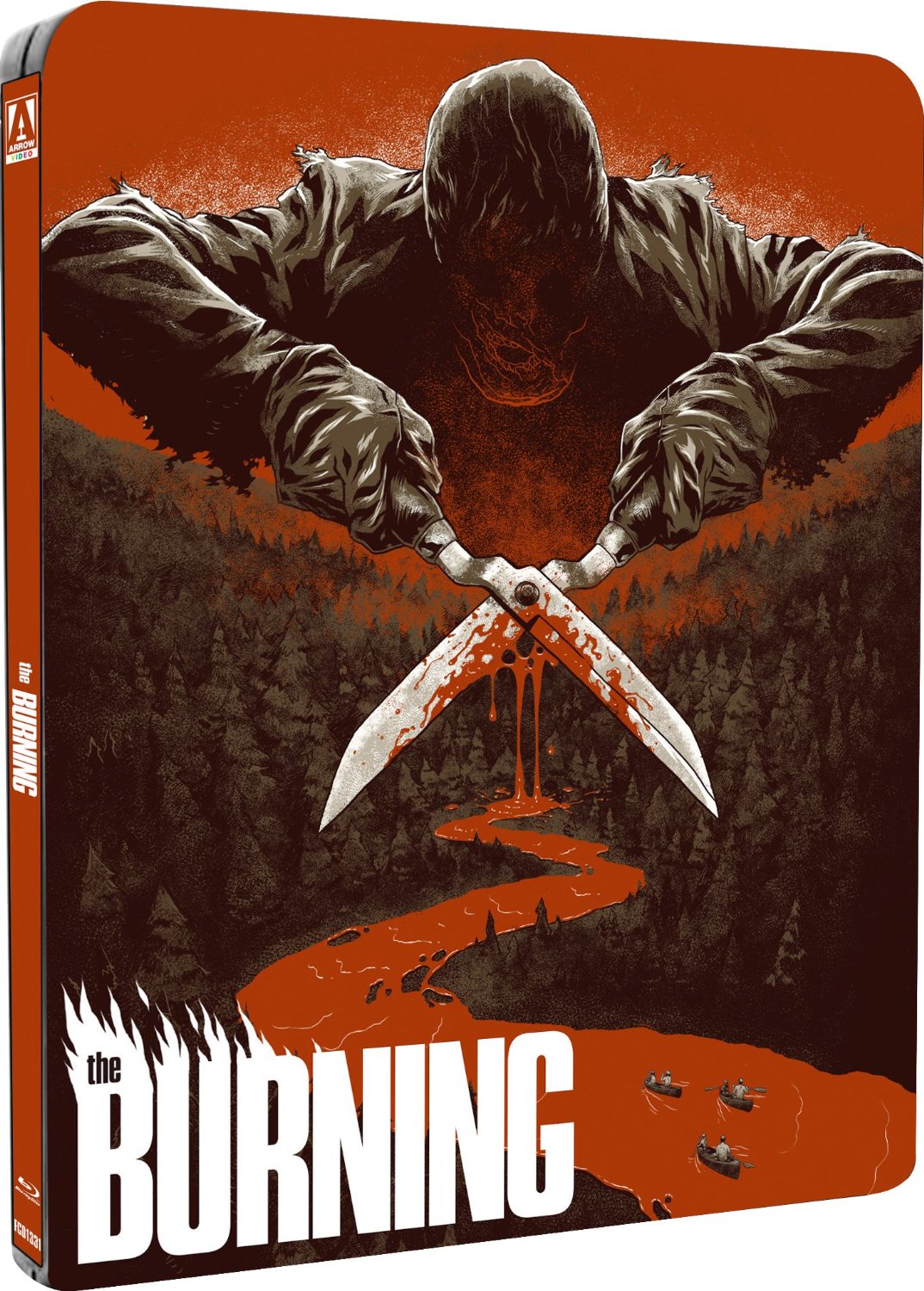 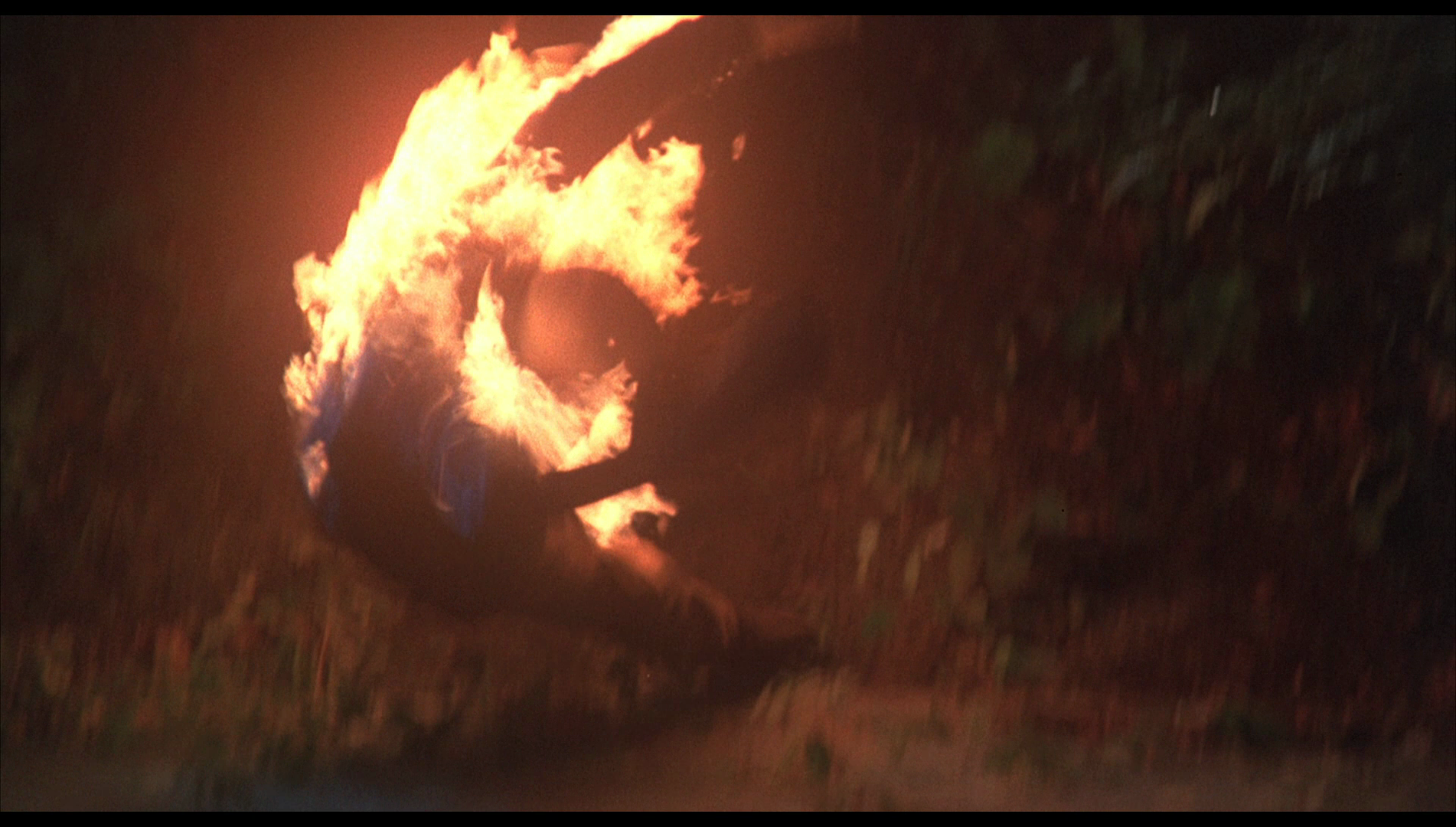 The Burning (Tony Maylam, 1981) The Burning (Tony Maylam, 1981)
One of the most striking pictures to come out of the boom period of bodycount/slasher movies made in the wake of the twin successes of Halloween (John Carpenter, 1978) and Friday the 13th (Sean S Cunningham, 1980), The Burning (Tony Maylam, 1981) was one of two films released in relatively close proximity about the legend of the ‘Cropsey Maniac’ (in The Burning, ‘Cropsey’ becomes ‘Cropsy’), a campfire tale circulated amongst the children who attended New York’s summer camps about an escaped mental patient who, driven by revenge, would snatch and murder children. In the various versions of the story, Cropsey would either carry an axe or have a hook for a hand; the common element to all tellings of the tale was Cropsey’s profound desire to murder children in incredibly brutal ways. The story of the Cropsey Maniac was the subject of an article by Lee Haring and Mark Breslerman that was published in a 1977 issue of New York Folklore (Haring and Breslerman, 1977). In their words, the legend of the Cropsey Maniac revolves around ‘a respected member if the community whose insane desire to avenge an accidental death [in most versions of the story, of his son] prompts him to stalk the outskirts of the camp property as a revenant’ (ibid.). In more recent years, the story of Cropsey has been the subject of a 2009 documentary (titled Cropsey) by Barbara Branciacco and Joshua Zeman. Branciacco and Zeman’s documentary connects the legend of the Cropsey Maniac to the crimes of convicted child kidnapper and suspected serial killer Andre Rand. The Burning begins at Camp Blackfoot, where a group of young men set up a prank intended to scare the living daylights out of Cropsy (Lou David), the summer camp’s caretaker who has a habit of being cruel to the young people attending the camp. However, the prank goes badly awry when, in terror, Cropsy knocks a candle onto the bed on which he’s sleeping and the fire spreads. On fire, Cropsy runs out of his cabin and dives into a nearby creek. 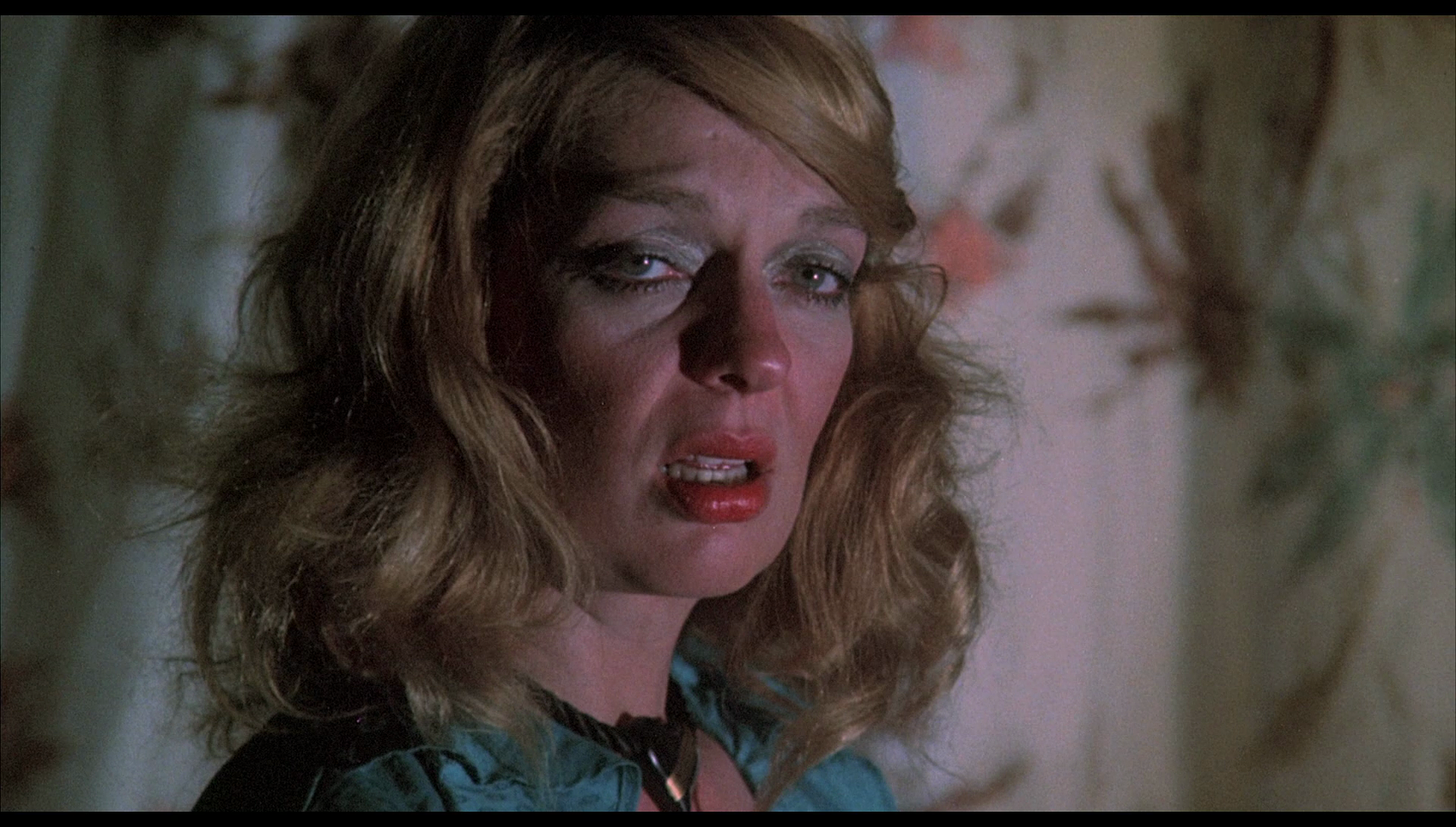 Five years later, Cropsy is released from hospital – alive but carrying with him the permanent scars of the prank-gone-wrong. One of the first things Cropsy does is approach a prostitute, who takes him to her apartment but recoils in horror when he reveals his face to her. In response to this, Cropsy stabs the woman to death with a pair of scissors. Five years later, Cropsy is released from hospital – alive but carrying with him the permanent scars of the prank-gone-wrong. One of the first things Cropsy does is approach a prostitute, who takes him to her apartment but recoils in horror when he reveals his face to her. In response to this, Cropsy stabs the woman to death with a pair of scissors.
The film then takes us to Camp Stonewater, another summer camp. During a game of softball, the boys leer at the scantily-clad girls. The ball is hit into the woodland surrounding the field, and one of the girls runs after it. She finds the ball, but she is unaware that Cropsy is hiding in the bushes with a pair of shears in his hand. She escapes without Cropsy revealing himself to her, but the threat has been established for the audience. At the camp, the girls complain about Alfred (Brian Backer), who they claim has been spying on them in the showers. Alfred is taken under the wing of one of the camp counselors, Todd (Brian Matthews), who advises him to watch his behaviour and reveals that he himself was thrown out of camp as a young(er) teenager for an undisclosed indiscretion. However, Alfred finds himself the target of bullying counselor Glazer (Larry Joshua), who is involved in a sexual relationship with one of the teenagers attending the camp, Sally (Carrick Glenn). Despite Todd’s warnings (‘You cause any problems for any kid in this camp, I’m gonna bust your ass’), Glazer continues to place pressure on Alfred. However, Alfred is assisted by his friend Dave (Jason Alexander) and some of the other young men, who humiliate Glazer by shooting him with a BB gun whilst he is showing off to the girls. 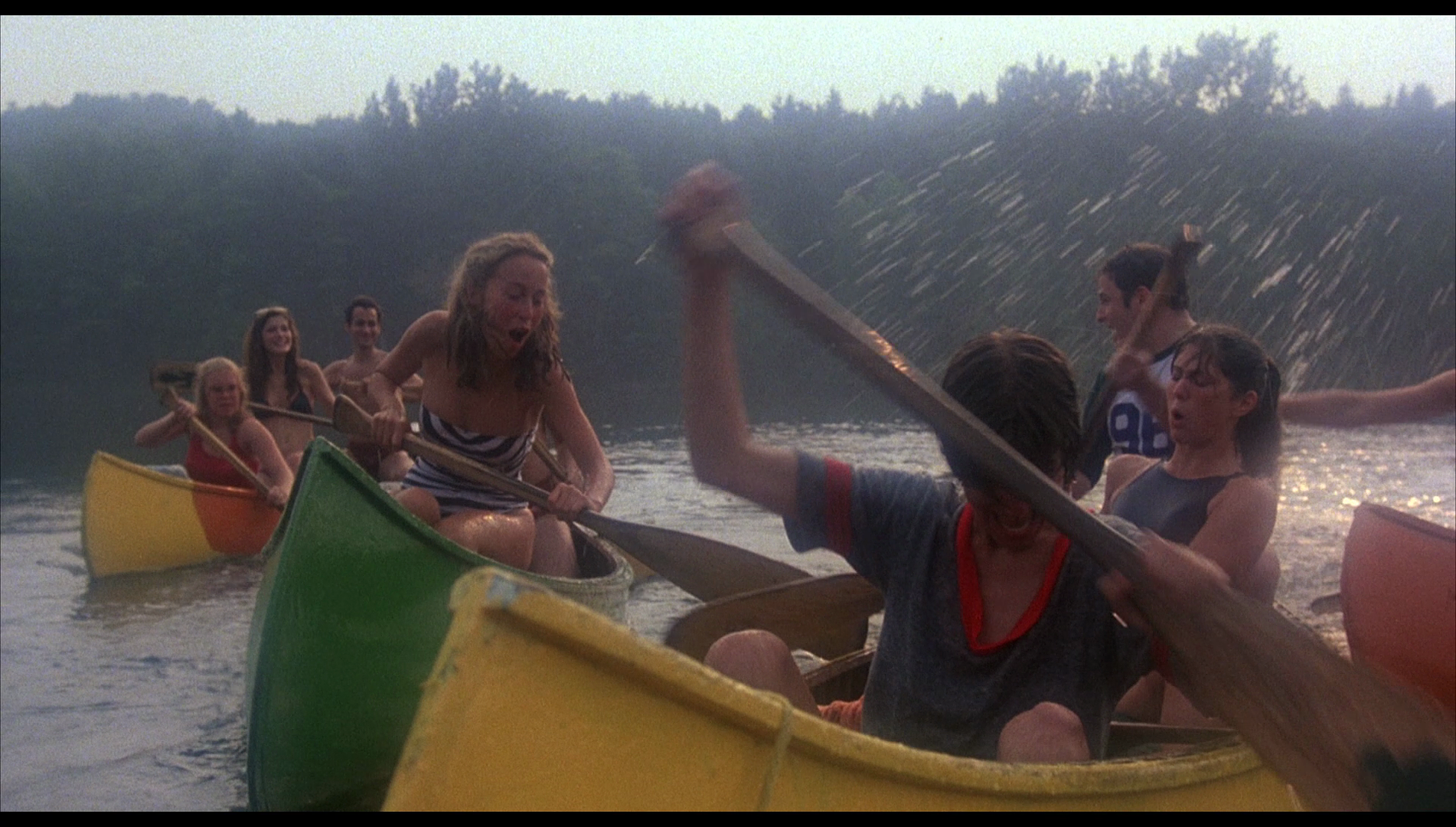 Some of the counselors and older children take a three day canoe trip to Devil’s Creek, which unbeknownst to at least some of them is the site of the former Camp Blackfoot. There, round a campfire, Todd tells the story of Cropsy, the terror of the story compounded by the fact that Eddy (Ned Eisenberg) jumps out of the woods wearing a Hallowe’en mask. Following the campfire tale, Eddy proposes a skinny dip to his paramour Karen (Carolyn Houlihan). However, when Eddy comes on too strong, Karen leaves him and wanders into the woods, where she is killed by Cropsy. In the morning, the counselors and their charges realise that Karen is missing, and they also discover that the canoes they used to travel to Devil’s Creek have disappeared. They begin to construct a raft which will enable some of them to return to the camp and seek help for the others. However, unbeknownst to those who remain at Devil’s Creek, Cropsy intercepts the raft and kills everyone on it. When the raft drifts back to Devil’s Creek, the mutilated corpses of those aboard it visible for all to see, the survivors become aware of the presence of Cropsy and the remaining counselors must devise a way to protect the surviving teenagers. Some of the counselors and older children take a three day canoe trip to Devil’s Creek, which unbeknownst to at least some of them is the site of the former Camp Blackfoot. There, round a campfire, Todd tells the story of Cropsy, the terror of the story compounded by the fact that Eddy (Ned Eisenberg) jumps out of the woods wearing a Hallowe’en mask. Following the campfire tale, Eddy proposes a skinny dip to his paramour Karen (Carolyn Houlihan). However, when Eddy comes on too strong, Karen leaves him and wanders into the woods, where she is killed by Cropsy. In the morning, the counselors and their charges realise that Karen is missing, and they also discover that the canoes they used to travel to Devil’s Creek have disappeared. They begin to construct a raft which will enable some of them to return to the camp and seek help for the others. However, unbeknownst to those who remain at Devil’s Creek, Cropsy intercepts the raft and kills everyone on it. When the raft drifts back to Devil’s Creek, the mutilated corpses of those aboard it visible for all to see, the survivors become aware of the presence of Cropsy and the remaining counselors must devise a way to protect the surviving teenagers.
The Burning hybridises the summer camp slasher subgenre (in the manner of Friday the 13th or Robert Hiltzik’s Sleepaway Camp, 1983) with the backwoods/rural slasher type (in the style of Jeff Lieberman’s Just Before Dawn, 1981, or Andrew Davis’ The Final Terror, 1983). The transition from the paradigms of the summer camp bodycount picture to the backwoods slasher film takes place midway through the picture, when the older children make the journey from the summer camp to Devil’s Creek in their canoes. 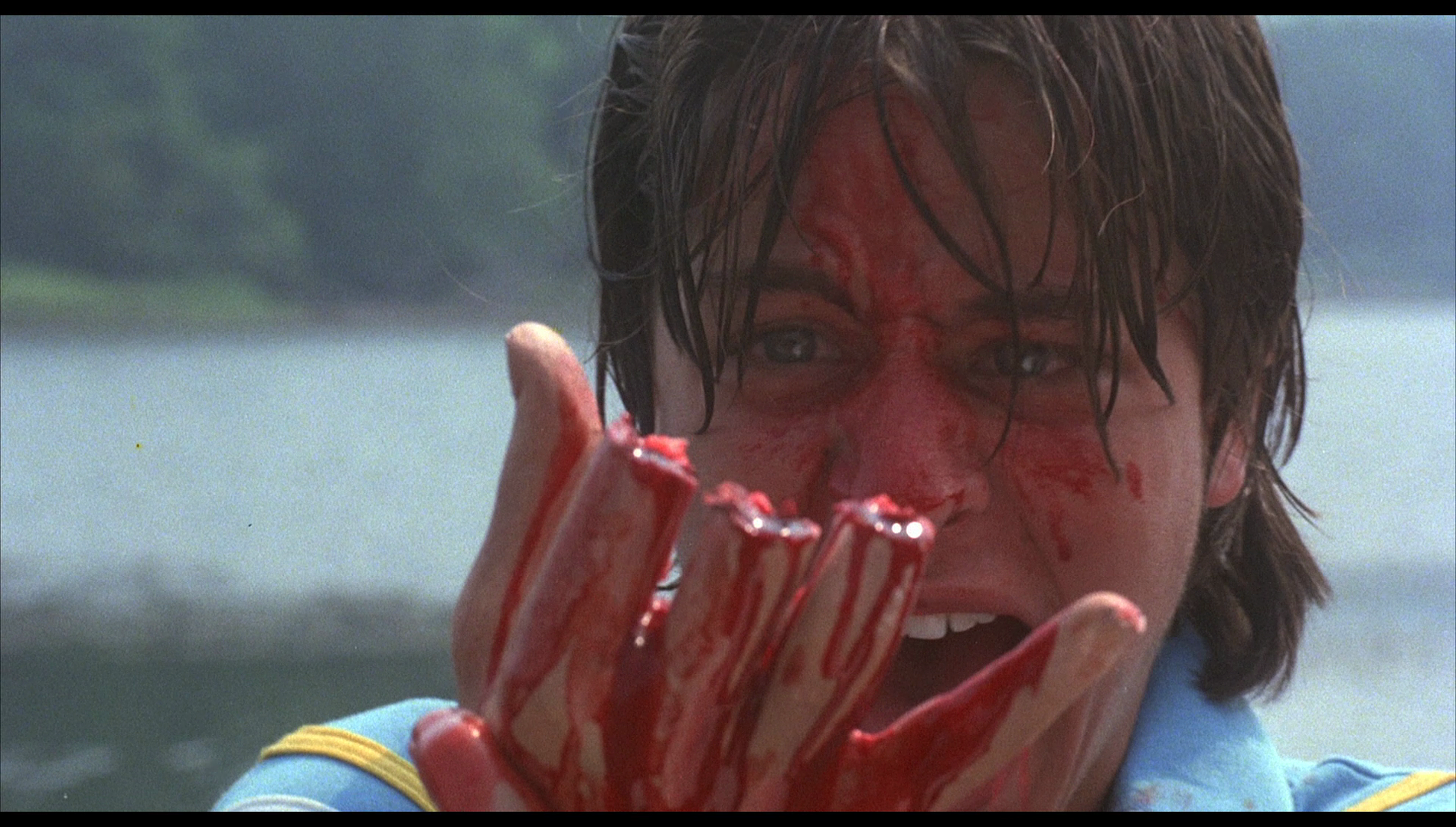 The Burning was one of the first films to be produced by Harvey and Bob Weinstein’s company Miramax Films. The Weinstein brothers secured a strong team behind the scenes, including Rick Wakeman as the composer of the film’s soundtrack and Tom Savini as the designer of the film’s make-up effects. Savini’s effects for this picture are amongst the best in any slasher film, and The Burning offers a potent, disarming mix of extremely grisly, realistic effects work and full frontal nudity that is atypical for an American slasher film. Because of this, the film ran into censorship problems in America, where the MPAA demanded cuts to the sequence in which Cropsy attacks the youths traveling by raft from Devil’s Creek back to the main camp – a sequence in which Cropsy springs out of the water, using his shears to cut the fingers off the hand of one significant character, stabbing the shears into the chest of another and leaving a third character with a deep wound to the scalp. In the UK, The Burning was released in a cut form to UK cinemas; this version of the film featured cuts to two scenes of violent content. Cropsy’s attack on the prostitute, after he is released from the hospital, was trimmed; later in the film, Cropsy’s assault on the young people on the raft was shorn of the shot of one of the victims holding his hand, from which Cropsy has sheared his fingers, and another shot of another victim coughing up blood. The Burning was one of the first films to be produced by Harvey and Bob Weinstein’s company Miramax Films. The Weinstein brothers secured a strong team behind the scenes, including Rick Wakeman as the composer of the film’s soundtrack and Tom Savini as the designer of the film’s make-up effects. Savini’s effects for this picture are amongst the best in any slasher film, and The Burning offers a potent, disarming mix of extremely grisly, realistic effects work and full frontal nudity that is atypical for an American slasher film. Because of this, the film ran into censorship problems in America, where the MPAA demanded cuts to the sequence in which Cropsy attacks the youths traveling by raft from Devil’s Creek back to the main camp – a sequence in which Cropsy springs out of the water, using his shears to cut the fingers off the hand of one significant character, stabbing the shears into the chest of another and leaving a third character with a deep wound to the scalp. In the UK, The Burning was released in a cut form to UK cinemas; this version of the film featured cuts to two scenes of violent content. Cropsy’s attack on the prostitute, after he is released from the hospital, was trimmed; later in the film, Cropsy’s assault on the young people on the raft was shorn of the shot of one of the victims holding his hand, from which Cropsy has sheared his fingers, and another shot of another victim coughing up blood.
In 1983, The Burning was released on VHS in the UK by Thorn EMI. Thorn EMI’s initial cassette contained an uncut version of the film, though they also released a cassette which conformed to the version of the film shown in UK cinemas. Thorn EMI’s uncut tape led to the film being placed on the Director of Public Prosecution’s list of ‘video nasties’. However, in 1992 the film was submitted to the BBFC for home video classification by Vipco, and suffered further cuts in addition to those made by the BBFC for the film’s UK cinema release. Vipco’s video release also cut a shot in which one of the female characters is slashed across the neck by Cropsy, and her blood is shown flowing over her exposed cleavage (blood on breasts being a particular no-no for the BBFC at that point in time), and another moment during the massacre on the raft in which one of the female characters is shown with a gaping wound in her forehead. (This Blu-ray release from Arrow is thankfully uncut, the BBFC’s previous cuts having been waived.)  In its origins in the legend of Cropsey, The Burning was accompanied by Joe Giannone’s Madman (also 1981), which took its cues from the same campfire tale. (Please see our review of Arrow’s Blu-ray release of Madman here.) The production of The Burning reputedly led the makers of Madman to subject the script to a hasty rewrite before production began with the intention of removing all direct references to the Cropsey Maniac, who in original drafts of the screenplay was the film’s antagonist, and renaming the villain of the piece ‘Madman’ Marz. There are some interesting similarities between The Burning and Madman. Both films feature the telling of a Cropsey-like story around a campfire. Madman begins with this campfire scene, framing the narrative that follows and giving the film a strong sense of reflexivity. The Burning’s comparable campfire scene takes place much later in its narrative, once the group of older children have travelled by canoe to Devil’s Creek; this scene is reiterated at the end of the picture, suggesting a continuation of the story of Cropsy – and ends with the counselor telling the tale addressing the audience directly (‘Don’t look: he’ll see you. Don’t move: he’ll hear you. Don’t breathe … You’re dead!’). In The Burning, the telling of the story of Cropsy (clearly modeled on the campfire stories of the Cropsey Maniac) is given added irony by the fact that the storyteller was one of the people who was responsible for Cropsy’s injuries – and thus the story-within-a-film is revealed to be entirely factual, and presented as a first-hand account that is wrapped up in the rhetoric of myth and legend. In its origins in the legend of Cropsey, The Burning was accompanied by Joe Giannone’s Madman (also 1981), which took its cues from the same campfire tale. (Please see our review of Arrow’s Blu-ray release of Madman here.) The production of The Burning reputedly led the makers of Madman to subject the script to a hasty rewrite before production began with the intention of removing all direct references to the Cropsey Maniac, who in original drafts of the screenplay was the film’s antagonist, and renaming the villain of the piece ‘Madman’ Marz. There are some interesting similarities between The Burning and Madman. Both films feature the telling of a Cropsey-like story around a campfire. Madman begins with this campfire scene, framing the narrative that follows and giving the film a strong sense of reflexivity. The Burning’s comparable campfire scene takes place much later in its narrative, once the group of older children have travelled by canoe to Devil’s Creek; this scene is reiterated at the end of the picture, suggesting a continuation of the story of Cropsy – and ends with the counselor telling the tale addressing the audience directly (‘Don’t look: he’ll see you. Don’t move: he’ll hear you. Don’t breathe … You’re dead!’). In The Burning, the telling of the story of Cropsy (clearly modeled on the campfire stories of the Cropsey Maniac) is given added irony by the fact that the storyteller was one of the people who was responsible for Cropsy’s injuries – and thus the story-within-a-film is revealed to be entirely factual, and presented as a first-hand account that is wrapped up in the rhetoric of myth and legend.
Campfire stories such as that of the Cropsey Maniac serve an important function in the very American tradition of the summer camp: as Haring and Breslerman suggest, such tales help to ensure that the young people attending such camps demonstrate solidarity, working together; and they also reinforce the importance of respecting the rules of such camps, especially the commandment that attendees should not stray off the camp’s grounds (ibid.). In this film, the violent attentions of Cropsy are instigated by the cruel practical joke played upon him in the film’s opening sequence; it’s a practical joke that results in Cropsy being burnt and disfigured accidentally. Cropsy’s subsequent mania is shown as having a subtle sexual dimension, when after his release from hospital he visits the prostitute and kills her in what seems to be a fit of rage caused by the repulsion she expresses towards his appearance. The scene, shot entirely from Cropsy’s point-of-view as he approaches the middle-aged woman on a set of stairs and follows her up to her apartment, has strong echoes of the opening murder of the prostitute by Mark Lewis (Carl Boehm) in Michael Powell’s Peeping Tom (1960). This sexual dimension to Cropsy’s sadism echoes subtly through the film, in the scene in which he kills a young woman by slashing her throat with his shears and the blood from the wound is shown running down her exposed cleavage. 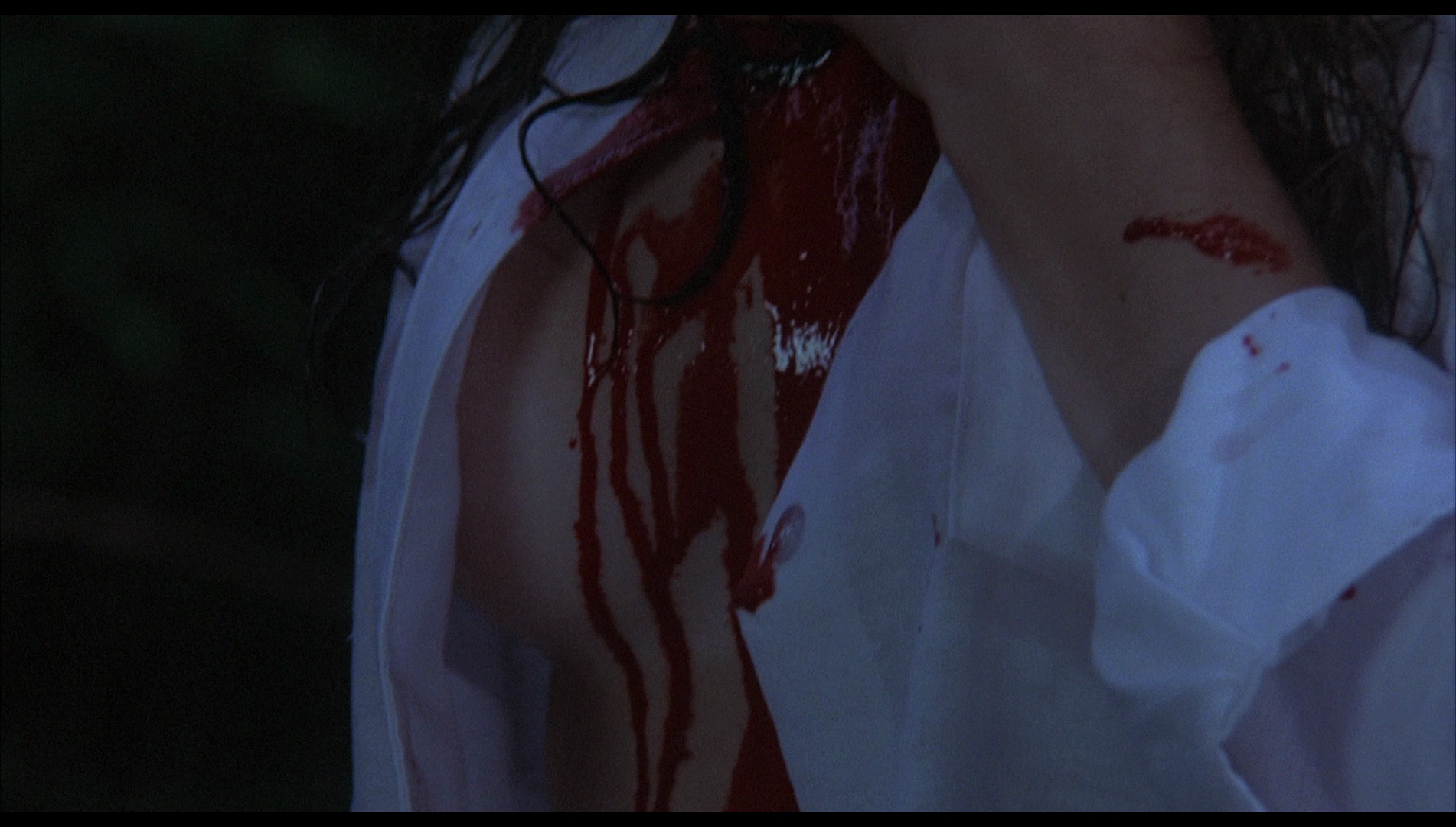 Cropsy’s psychosexual perversion connects him with Alfred, who is introduced spying on one of the young women as she showers. Alfred’s voyeuristic gaze is matched with that of the camera: the image of the young woman in the shower includes a heavy focus on her bare breasts, emphasised by the use of a low angle shot from within the shower itself. Compounding the perception of Alfred as a pervert, the girl suggests that he was not only watching her but also masturbating. Later, at Devil’s Creek, Alfred participates in voyeurism again when he watches from the distance as Glazer aggressively seduces Sally, which leads to Alfred witnessing Cropsy’s murder of this couple. However, as the film makes clear from its early sequences, despite what the others say, Alfred’s voyeuristic impulse and his objectification of the girls isn’t exactly abnormal: in fact, it’s something that links Alfred with his peers (Dave, for example, ogling the bottom of one of the girls during a softball game; his focus on this young woman’s behind is reinforced via the camera’s lingering close-up on the object of his gaze), but which because of Alfred’s curious manner is interpreted by some of the others as an index of deviance. The connection between Alfred and Cropsy is reinforced by the fact that Alfred is the first to see Cropsy, whose face appears at a window, and when Alfred tells the others about this, they refuse to believe him; then, finally, at the climax of the film, Alfred becomes the ‘princess’ who needs to be rescued from the proverbial dragon (Cropsy), with Todd coming to the aid of the teenager. Cropsy’s psychosexual perversion connects him with Alfred, who is introduced spying on one of the young women as she showers. Alfred’s voyeuristic gaze is matched with that of the camera: the image of the young woman in the shower includes a heavy focus on her bare breasts, emphasised by the use of a low angle shot from within the shower itself. Compounding the perception of Alfred as a pervert, the girl suggests that he was not only watching her but also masturbating. Later, at Devil’s Creek, Alfred participates in voyeurism again when he watches from the distance as Glazer aggressively seduces Sally, which leads to Alfred witnessing Cropsy’s murder of this couple. However, as the film makes clear from its early sequences, despite what the others say, Alfred’s voyeuristic impulse and his objectification of the girls isn’t exactly abnormal: in fact, it’s something that links Alfred with his peers (Dave, for example, ogling the bottom of one of the girls during a softball game; his focus on this young woman’s behind is reinforced via the camera’s lingering close-up on the object of his gaze), but which because of Alfred’s curious manner is interpreted by some of the others as an index of deviance. The connection between Alfred and Cropsy is reinforced by the fact that Alfred is the first to see Cropsy, whose face appears at a window, and when Alfred tells the others about this, they refuse to believe him; then, finally, at the climax of the film, Alfred becomes the ‘princess’ who needs to be rescued from the proverbial dragon (Cropsy), with Todd coming to the aid of the teenager.
There is no ambiguity surrounding the identity of the killer: the film’s opening sequence makes clear Cropsy’s motivations, and there is a sense of inevitability to his stalking of the summer camp. Like Jason Voorhees in Friday the 13th, Part 2 (Steve Miner, 1981) and Michael Myers in Halloween, Cropsy is motivated largely by revenge. However, unlike Voorhees or Myers, Cropsy isn’t a supernatural figure: he is utterly corporeal, his corporeality foregrounded through the physicality of the scars he carries from the prank-gone-wrong depicted in the precredits sequence rather than the use of a mask (be it a hockey mask or a William Shatner mask) as an almost supernatural totem in the manner of Michael Myers or Jason Voorhees. The devastation that the prank depicted in the opening sequence causes to Cropsy’s face and body is highlighted in the following scene, in which a junior doctor arrives at a hospital and speaks with a more seasoned orderly. The orderly tells the young doctor of the badly burned Cropsy: ‘After you see this guy’, the orderly says, ‘you’ll never want to come back in here again. This guy is fucking cooked. A Big Mac, overdone [….] He’s a monster, man’. The orderly’s words draw an association between Cropsy’s horrendous appearance and the notion of him being a ‘monster’ in terms of his behaviour. ‘Now, this is burns’, the orderly continues, showing the doctor the seemingly unconscious Cropsy, ‘You ain’t never gonna forget this, man. As long as you live, you ain’t never gonna see a freak like this’. The sense of dread is amped up as the camera presents the approach to Cropsy’s bed from the junior doctor’s point-of-view, the orderly pulling back the curtains around Cropsy as if they were the curtains of a theatre, his verbal introduction to the shock of seeing the badly burned Cropsy reminiscent of the type of showman’s patter used to introduced carnival freaks in bygone years (and captured in freak show ringmaster Bytes’ introduction to John Merrick in David Lynch’s The Elephant Man, 1980). With Cropsy established through the dialogue as a ‘monster’ and a ‘freak’, when his badly burnt arm reaches out through the curtains to grab the orderly, the orderly screams in terror. 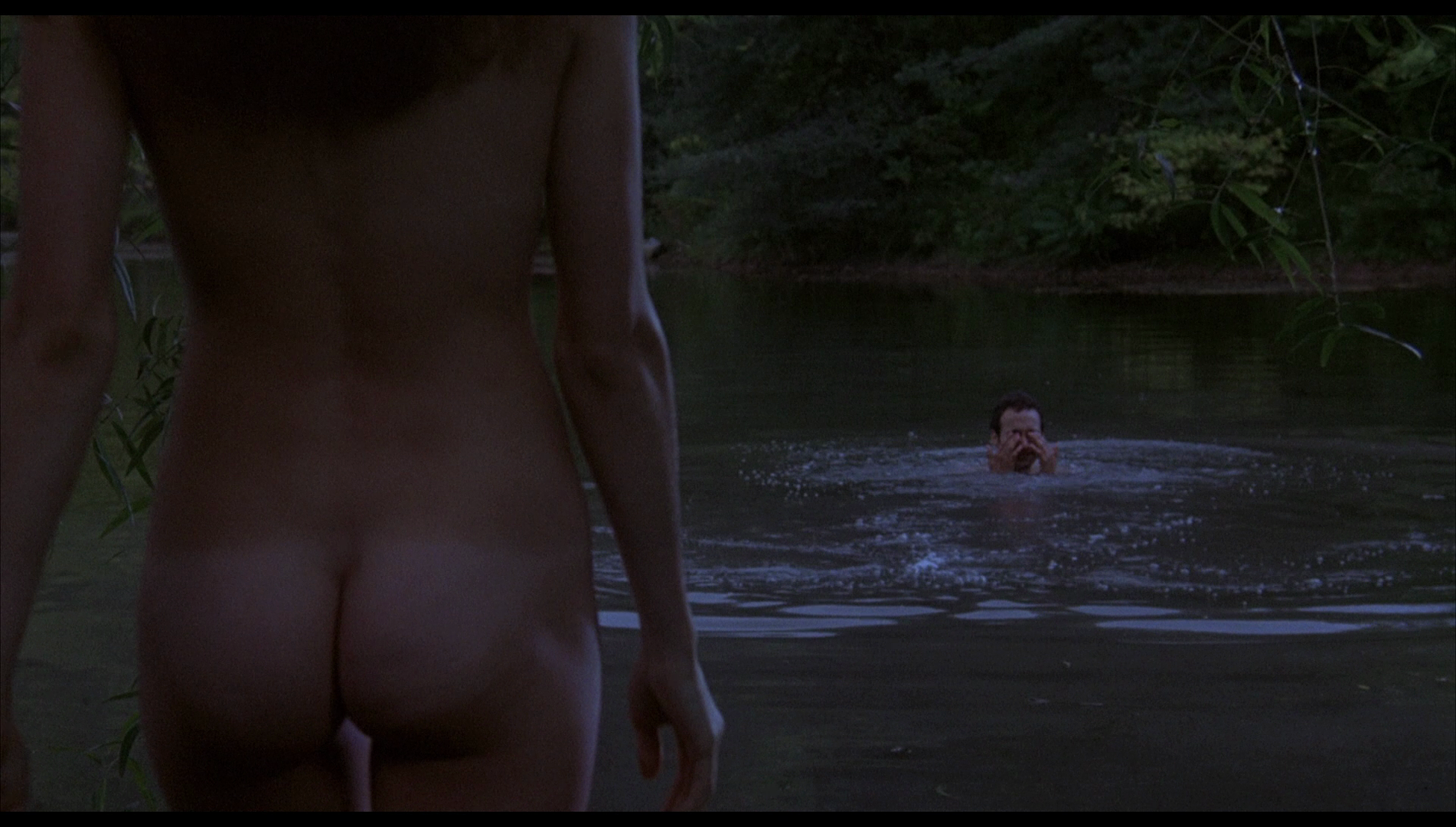 A title card takes us five years into the future, when Cropsy is released from the hospital. We are presented with his point-of-view, which keeps his ‘monstrous’ appearance from being revealed to the audience, as on the audio track we hear various moments of overlapping dialogue, advice given to Cropsy upon his release: ‘We’re sorry. The skin grafts just didn’t take’, a male voice says; ‘You’ve got to forget your hatred’, a female voice asserts, ‘Control your feelings for revenge’. Only towards the end of the film do the audience begin to realise that Cropsy is out for revenge against a specific member of the group that headed to Devil’s Creek: the role of this individual in Cropsy’s fate isn’t revealed until the second half of the picture. Jim Harper highlights the fact that The Burning is a rare instance of a slasher film from the boom period of the cycle which doesn’t feature a ‘Final Girl’: in other words, a female protagonist who through her actions defeats the villain of the picture (Harper, 2004: 31). Harper links The Burning with Friday the 13th, Part VI: Jason Lives (Tom McLoughlin, 1986) as ‘two cases where the central character of a slasher movie is male rather than female’ (ibid.). He reminds us that ‘[t]he most significant female in the film has no part in the end fight sequence, being busy getting the survivors to safety, and then simply welcoming the heroes home’ (ibid.). Harper suggests that ‘such examples’ of bodycount pictures which feature a male character in the final conflict with the antagonist, whilst the key female character is left in charge of the children, ‘are in a definite minority because they tend to revert to a very standard pattern of storytelling, a pattern that other slasher films with their female heroes have tried to break away from (ibid.). A title card takes us five years into the future, when Cropsy is released from the hospital. We are presented with his point-of-view, which keeps his ‘monstrous’ appearance from being revealed to the audience, as on the audio track we hear various moments of overlapping dialogue, advice given to Cropsy upon his release: ‘We’re sorry. The skin grafts just didn’t take’, a male voice says; ‘You’ve got to forget your hatred’, a female voice asserts, ‘Control your feelings for revenge’. Only towards the end of the film do the audience begin to realise that Cropsy is out for revenge against a specific member of the group that headed to Devil’s Creek: the role of this individual in Cropsy’s fate isn’t revealed until the second half of the picture. Jim Harper highlights the fact that The Burning is a rare instance of a slasher film from the boom period of the cycle which doesn’t feature a ‘Final Girl’: in other words, a female protagonist who through her actions defeats the villain of the picture (Harper, 2004: 31). Harper links The Burning with Friday the 13th, Part VI: Jason Lives (Tom McLoughlin, 1986) as ‘two cases where the central character of a slasher movie is male rather than female’ (ibid.). He reminds us that ‘[t]he most significant female in the film has no part in the end fight sequence, being busy getting the survivors to safety, and then simply welcoming the heroes home’ (ibid.). Harper suggests that ‘such examples’ of bodycount pictures which feature a male character in the final conflict with the antagonist, whilst the key female character is left in charge of the children, ‘are in a definite minority because they tend to revert to a very standard pattern of storytelling, a pattern that other slasher films with their female heroes have tried to break away from (ibid.).
Video
Taking up 25Gb of space on a dual-layered Blu-ray disc, Arrow’s presentation of The Burning is uncut, with the cuts imposed by the BBFC to the film’s previous home video releases having been waived. The film runs for 91:26 mins. The 1080p presentation uses the AVC codec, and the film is shown in its original aspect ratio of 1.85:1. 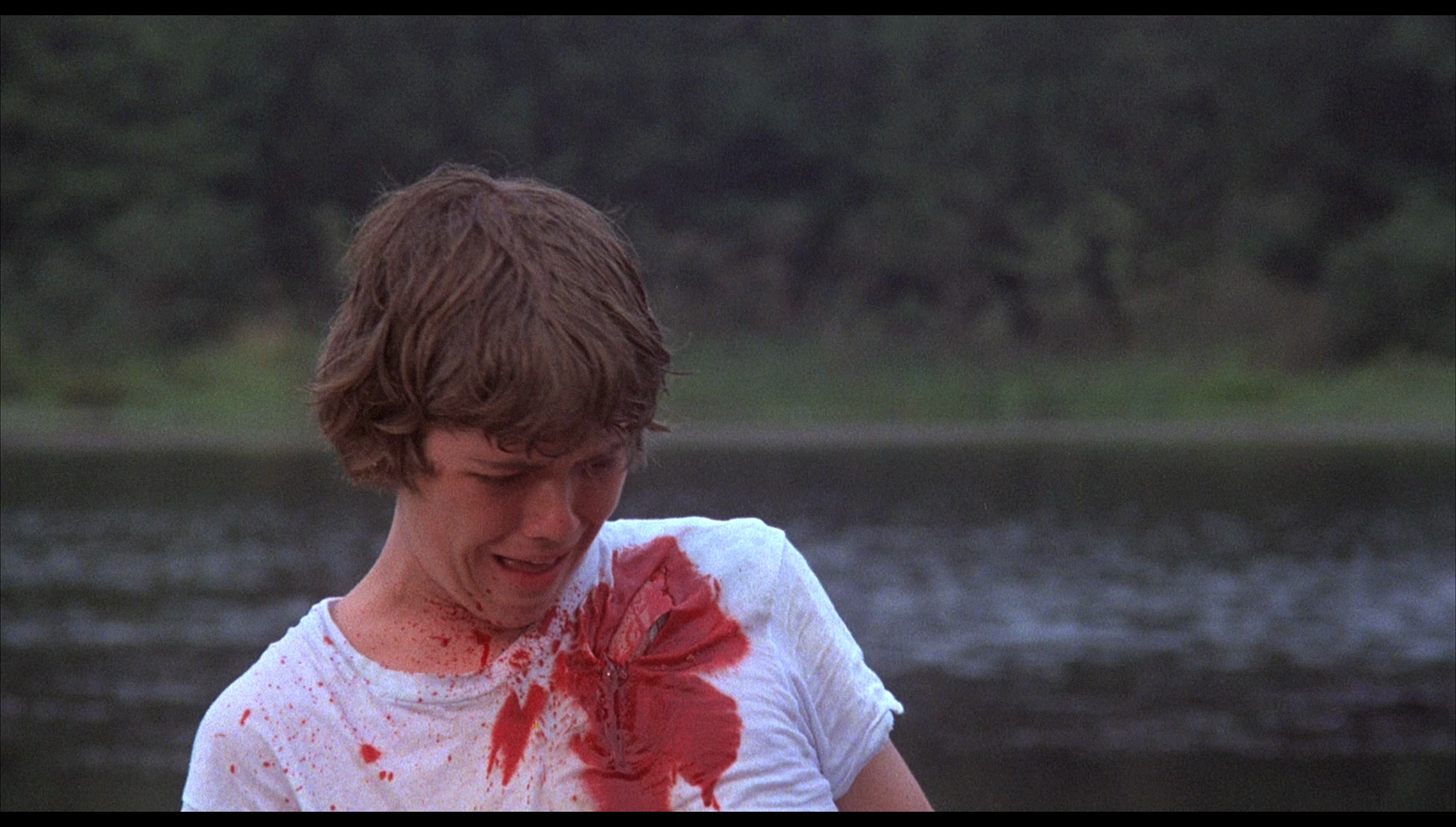 The film has previously been released on Blu-ray by Shout! Factory in the US. That disc was coded for playback in region ‘A’ players only. This release from Arrow represents the film’s first official region ‘B’-friendly Blu-ray release. Arrow’s presentation of the main feature is near-identical to Shout! Factory’s disc, and seems to be based on the same source (but with a stronger encode to disc). Arrow’s release is noticeably brighter, but in terms of differences between the two presentations that’s about it. (See the images at the bottom of this review for a direct comparison of the Arrow and Shout! Factory presentations.) The presentation displays solid contrast levels, which are evident from the opening sequence, set during nighttime: this sequence features a sense of depth to the image, with strong midtones, but also offers rich shadows. This sense of contrast is one area in which this HD presentation offers a significant improvement over the film’s DVD releases. The improved contrast levels become particularly important during the climax, which features the sets lit by shafts of diffused light. The film has previously been released on Blu-ray by Shout! Factory in the US. That disc was coded for playback in region ‘A’ players only. This release from Arrow represents the film’s first official region ‘B’-friendly Blu-ray release. Arrow’s presentation of the main feature is near-identical to Shout! Factory’s disc, and seems to be based on the same source (but with a stronger encode to disc). Arrow’s release is noticeably brighter, but in terms of differences between the two presentations that’s about it. (See the images at the bottom of this review for a direct comparison of the Arrow and Shout! Factory presentations.) The presentation displays solid contrast levels, which are evident from the opening sequence, set during nighttime: this sequence features a sense of depth to the image, with strong midtones, but also offers rich shadows. This sense of contrast is one area in which this HD presentation offers a significant improvement over the film’s DVD releases. The improved contrast levels become particularly important during the climax, which features the sets lit by shafts of diffused light.
The photography seems to display strong depth of field even in low light sequences, suggesting the use of predominantly shorter focal lengths during the shoot. (It’s perhaps worth noting that some shots from Cropsy’s point-of-view feature what seems to be Vaseline smeared at the periphery of the lens, offering a visual representation of the character’s single-minded focus on achieving revenge for what happened to him at Camp Blackfoot.) This sense of depth in the film’s original photography is communicated very well in this presentation, which offers a strong level of detail. Colour reproduction is good, skin tones feeling very natural. Finally, the encode is very strong and retains the structure of 35mm film. It’s a decent presentation, which seems to be based on an older master, and a big improvement over the film’s DVD releases; those who already own the Shout! Factory release, however, won’t notice a great deal of difference here – other than the encode, which in the case of the Arrow disc is noticeably stronger.  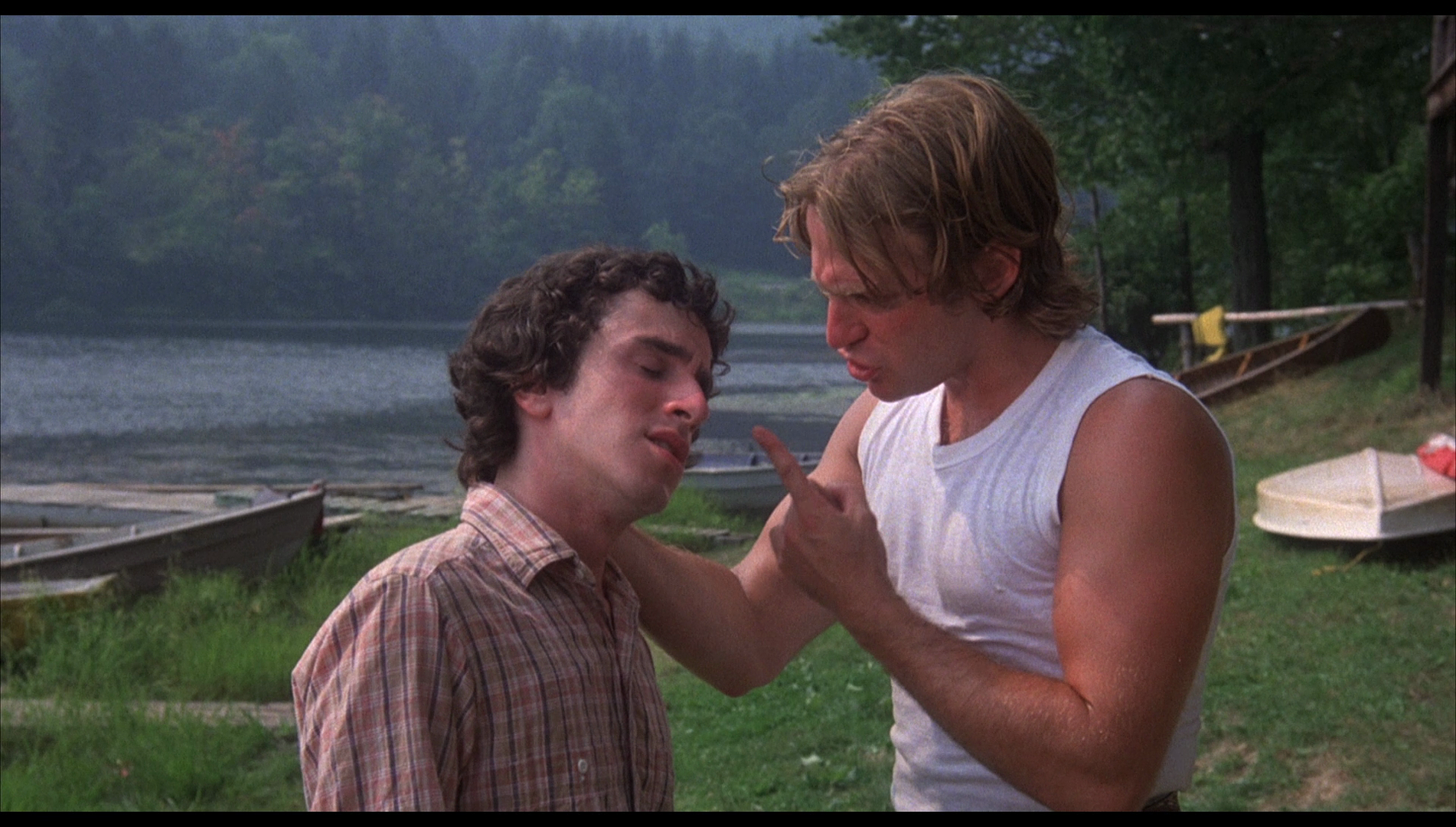
Audio
Audio is presented via a LPCM 1.0 mono track. This is clear throughout, Rick Wakeman’s score for the film being carried with depth and a sense of richness. Dialogue is audible throughout, even when whispered. Optional English subtitles for the Hard of Hearing are also included, and these are error free and easy to read.
Extras
The disc includes: 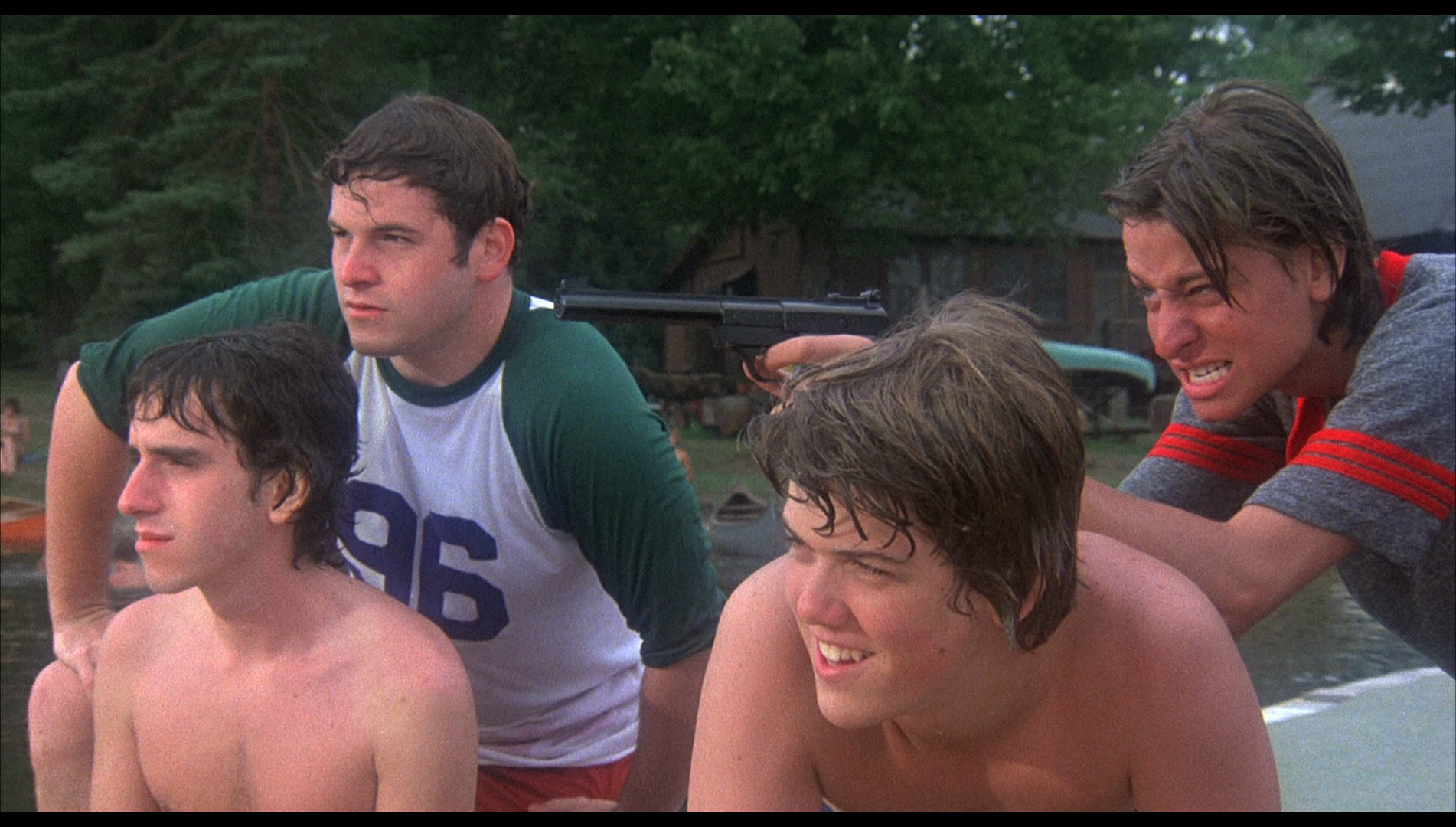 - An audio commentary with director Tony Maylam and critic Alan Jones. This is the same commentary that appeared on Shout! Factory’s Blu-ray release and the film’s R1 DVD release from around ten years ago. Maylam reflects on his career up to the point of the production of The Burning, and discusses his working relationships with the Weinsteins. The pair talk about horror films generally, with Maylam suggesting that his favourite horror picture is Alien (Ridley Scott, 1979). They discuss the casting and performances, and reflect on Savini’s involvement in designing the film’s makeup effects. - An audio commentary with director Tony Maylam and critic Alan Jones. This is the same commentary that appeared on Shout! Factory’s Blu-ray release and the film’s R1 DVD release from around ten years ago. Maylam reflects on his career up to the point of the production of The Burning, and discusses his working relationships with the Weinsteins. The pair talk about horror films generally, with Maylam suggesting that his favourite horror picture is Alien (Ridley Scott, 1979). They discuss the casting and performances, and reflect on Savini’s involvement in designing the film’s makeup effects.
- A second audio commentary with Shelley Bruce and Bonnie Deroski. This commentary also appeared on Shout! Factory’s US Blu-ray release. The two actresses talk about how they came to be cast on the film and the auditioning process. They discuss the locations used during the production, and the track is filled with anecdotes about the shooting of the film. - A third audio commentary with The Hysteria Continues. Here, in a new commentary track that is exclusive to this release, the contributors to The Hysteria Continues podcast discuss the film. They talk about their first encounters with the film and consider in detail its relationship with other examples of the slasher movie. There’s some good discussion of the effects work and Savini’s contribution to the film. They also talk about the film’s home video history in the UK and its censorship history. - ‘Blood ‘n’ Fire Memories’ (18:01). In this new interview, Tom Savini talks about the film’s make-up effects. It’s an excellent piece with Savini reflecting on his exceptional work for the film. 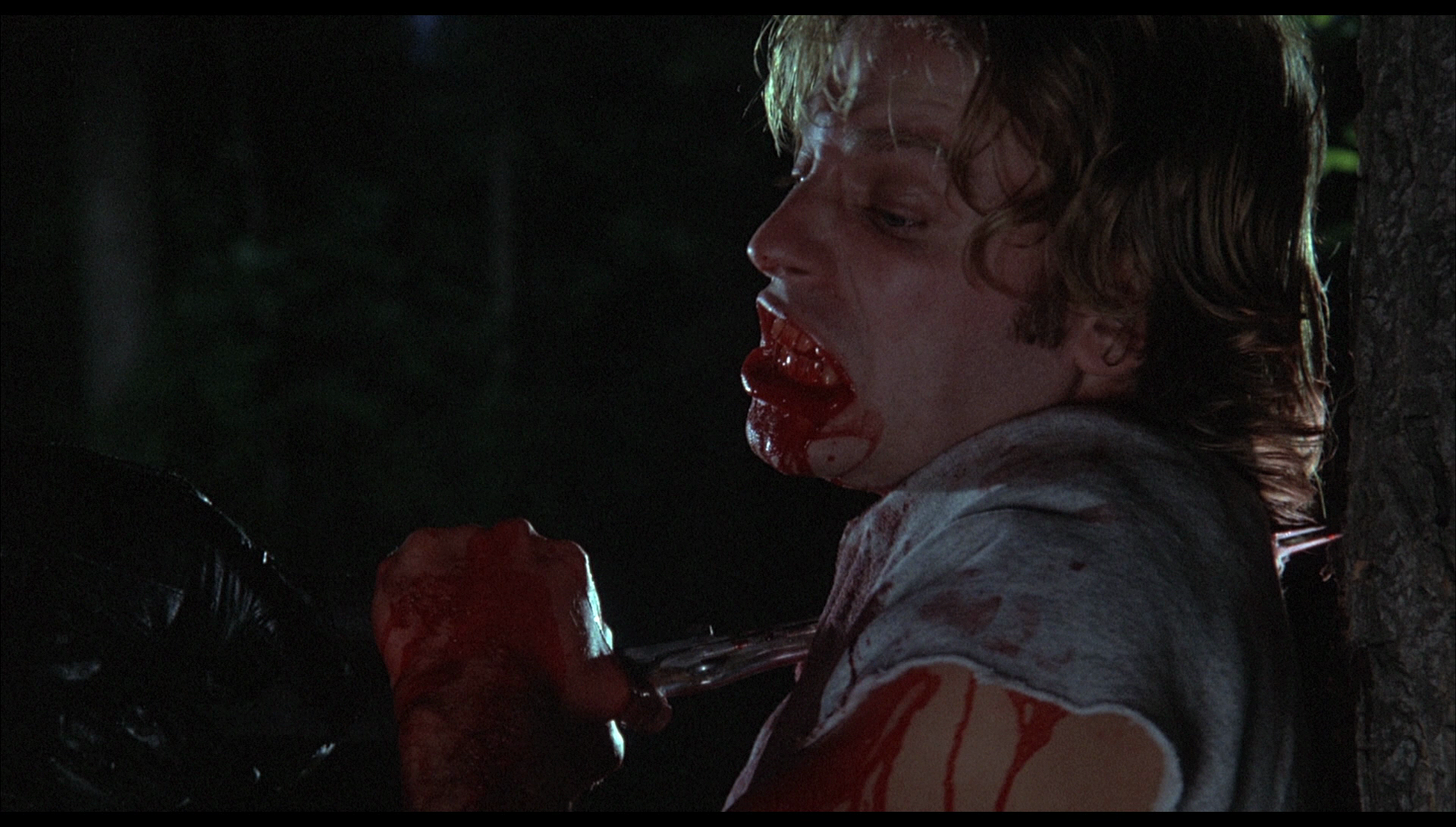 - ‘Slash and Cut’ (12:04). Here, in an interview that has been ported over from Shout! Factory’s US Blu-ray release, the film’s editor Jack Sholder discusses The Burning’s relationship with the paradigms of the slasher film before talking about how he came to be hired to edit the film and discussing the process of cutting the picture. - ‘Slash and Cut’ (12:04). Here, in an interview that has been ported over from Shout! Factory’s US Blu-ray release, the film’s editor Jack Sholder discusses The Burning’s relationship with the paradigms of the slasher film before talking about how he came to be hired to edit the film and discussing the process of cutting the picture.
- ‘Cropsy Speaks’ (11:19). In another interview ported over from Shout! Factory’s release, actor Lou David talks about Cropsy and his approach to playing the character. - ‘Summer Camp Nightmare’ (6:45). Actress Leah Ayres recollects shooting the film. This interview is again sourced from Shout! Factory’s Blu-ray release. - ‘Synthly the Best’ (11:32). Here, in a new interview, Rick Wakeman talks about how Tony Maylam approached him to compose the film’s music and reflects on some of the issues involved in working on a limited budget. He reveals that the film was originally intended to have an orchestrated score, but that the Weinsteins requested Wakeman compose the score for a synthesiser as a means of reducing the budget. - Behind-the-Scenes Footage (7:56). This is the same compilation of footage showing the production, shot on videotape on the set of the picture, that has been seen on Shout! Factory’s American Blu-ray release. The footage focuses on the effects work in the film, including the titular burning of Cropsy and the shooting of the raft scene. - Trailer (1:27). - Image Galleries: Make-Up Effects (2:25); Posters and Stills (3:05).
Overall
 A strong favourite of fans of the bodycount/slasher film, The Burning offers an interesting hybrid of the summer camp slasher and the backwoods/rural slasher picture. The lack of ambiguity surrounding the identity of the killer gives the film a strong sense of fatalism, whilst the absence of a ‘Final Girl’ makes the picture stand out from the majority of slasher films from the post-Halloween/post-Friday the 13th boom period. Aside from the lack of a ‘Final Girl’, The Burning follows the paradigms of the bodycount/slasher subgenre quite closely, but in comparison with many of its contemporaries it ‘ups the ante’ in terms of its inclusion of full frontal nudity, the language (the dialogue is laced with strong profanities) and, of course, Tom Savini’s incredibly effective makeup effects. Savini’s work here is, alongside his work on Joseph Zito’s The Prowler (1981), some of the most outstanding effects work in any of the classic slasher pictures: there’s a strong sense of realism to the violence on display here which was the reason for the censorship problems the film ran into both here and in America. A strong favourite of fans of the bodycount/slasher film, The Burning offers an interesting hybrid of the summer camp slasher and the backwoods/rural slasher picture. The lack of ambiguity surrounding the identity of the killer gives the film a strong sense of fatalism, whilst the absence of a ‘Final Girl’ makes the picture stand out from the majority of slasher films from the post-Halloween/post-Friday the 13th boom period. Aside from the lack of a ‘Final Girl’, The Burning follows the paradigms of the bodycount/slasher subgenre quite closely, but in comparison with many of its contemporaries it ‘ups the ante’ in terms of its inclusion of full frontal nudity, the language (the dialogue is laced with strong profanities) and, of course, Tom Savini’s incredibly effective makeup effects. Savini’s work here is, alongside his work on Joseph Zito’s The Prowler (1981), some of the most outstanding effects work in any of the classic slasher pictures: there’s a strong sense of realism to the violence on display here which was the reason for the censorship problems the film ran into both here and in America.
Though the main presentation isn’t immensely different from that included on Shout! Factory’s Blu-ray release in the US, Arrow’s Blu-ray release represents the film’s first official HD release in region ‘B’ territories and is a big improvement over the previously available DVDs. The presentation is solid, if not outstanding, and it is accompanied by some absolutely superb contextual material: new to this release, and particularly notable, are the interview with Savini about his makeup effects for the film, the comments from Wakeman about the music, and the enthusiastic commentary from the contributors to the The Hysteria Continues podcast. Some of this has been ported over from the film’s US Blu-ray release, but much of it is new and exclusive to this release. UK fans of slasher pictures will find this to be an excellent, rewarding purchase, and a good accompaniment to Arrow’s recent Blu-ray release of Joe Giannone’s Madman. References: Haring, Lee & Breslerman, Mark, 1977: ‘The Cropsey Maniac’. New York Folklore 3:(1-4) Harper, Jim, 2004: Legacy of Blood: A Comprehensive Guide to Slasher Movies. Manchester: Headpress/Critical Vision Visual comparison with the Shout! Factory Blu-ray release: Shout! Factory 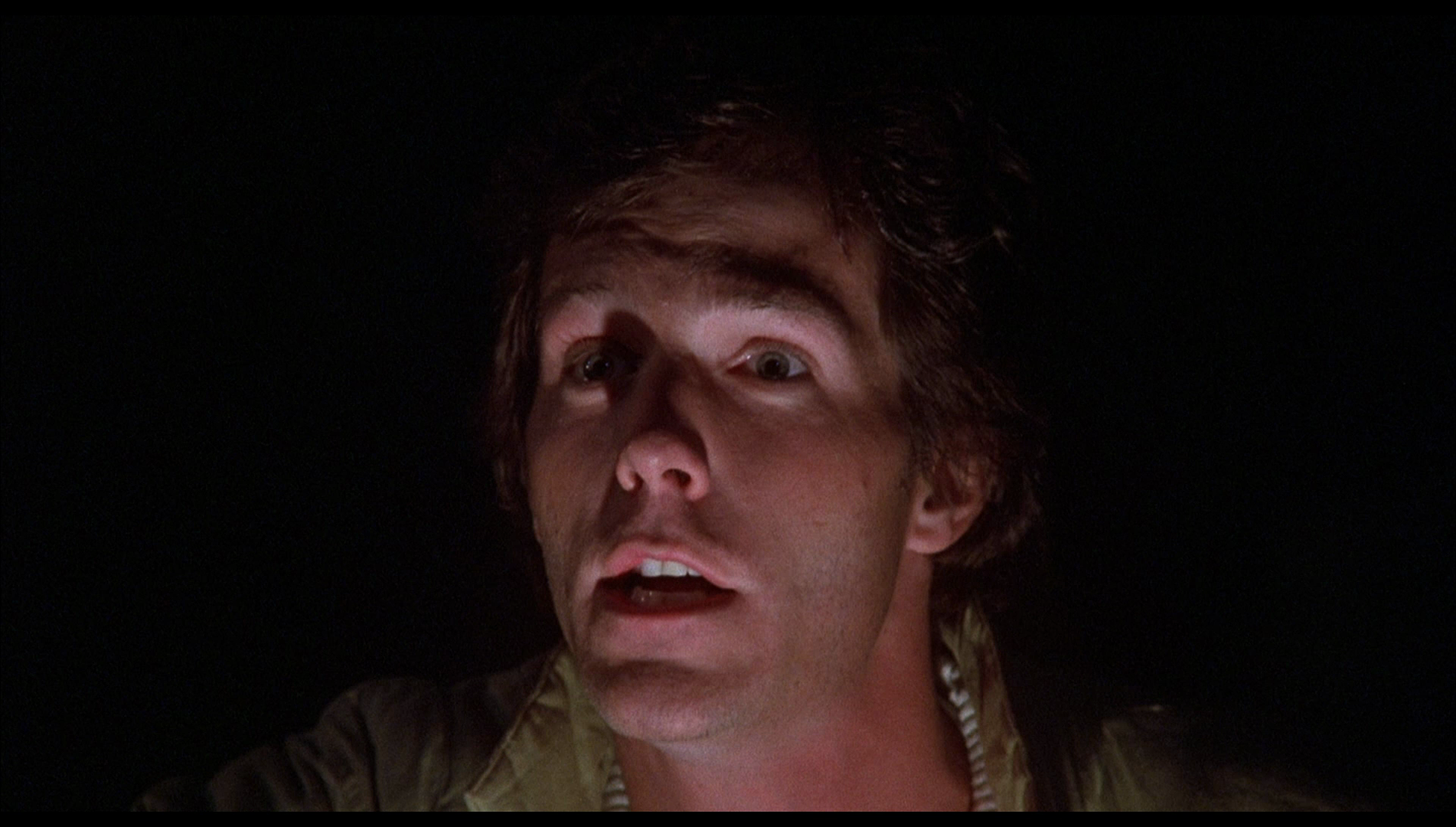
Arrow Video 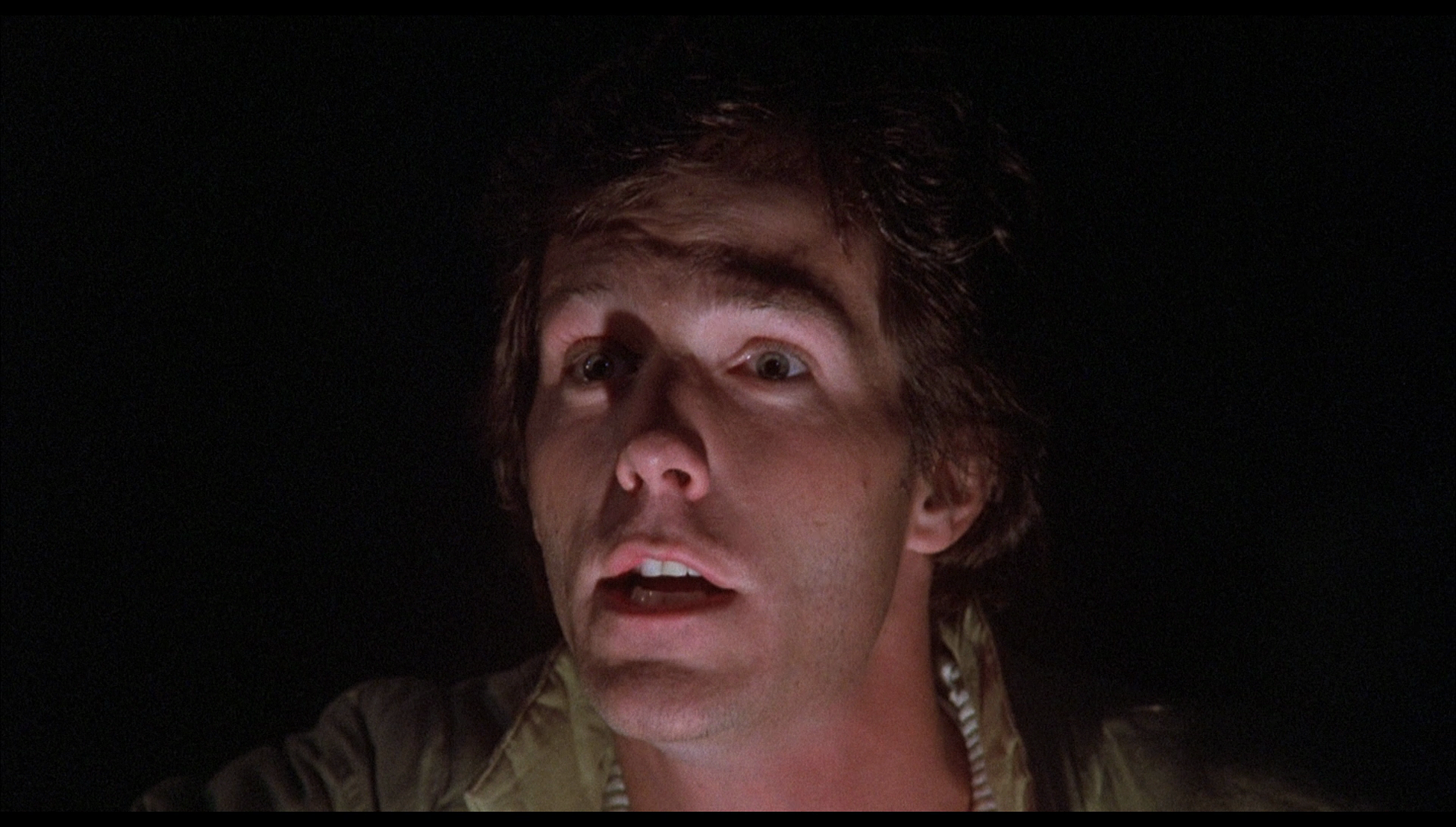
Shout! Factory 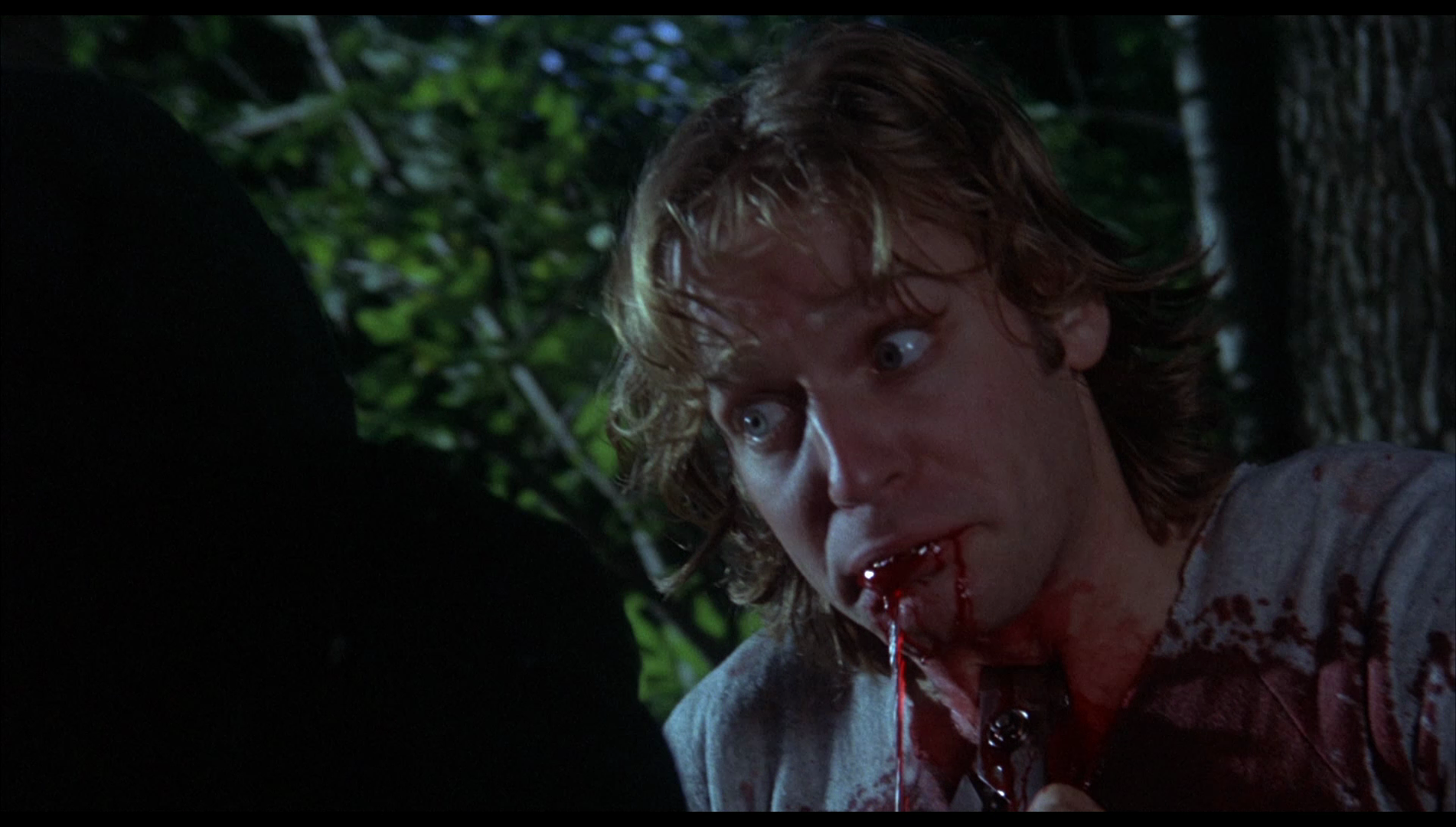
Arrow Video 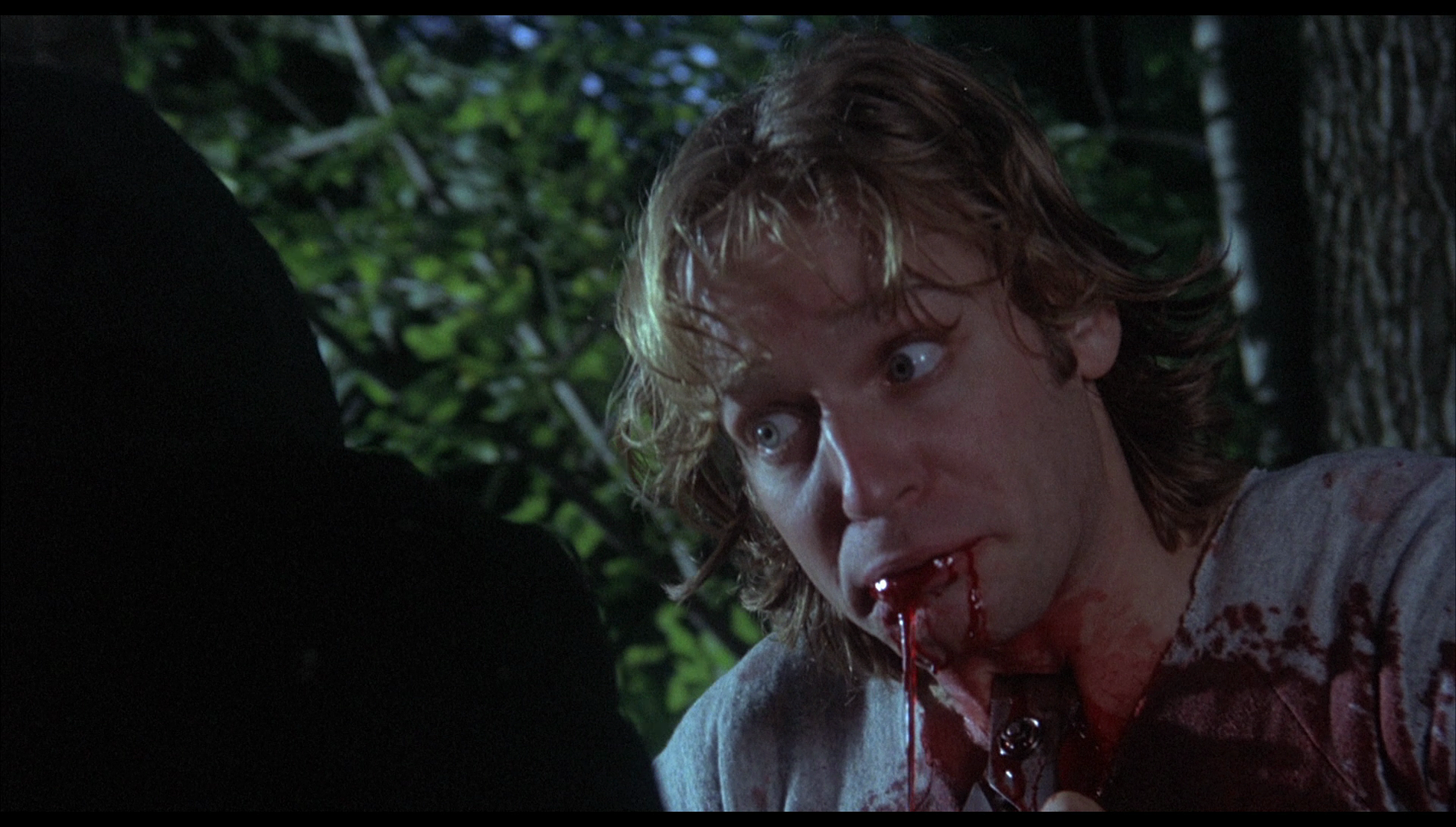
Shout! Factory 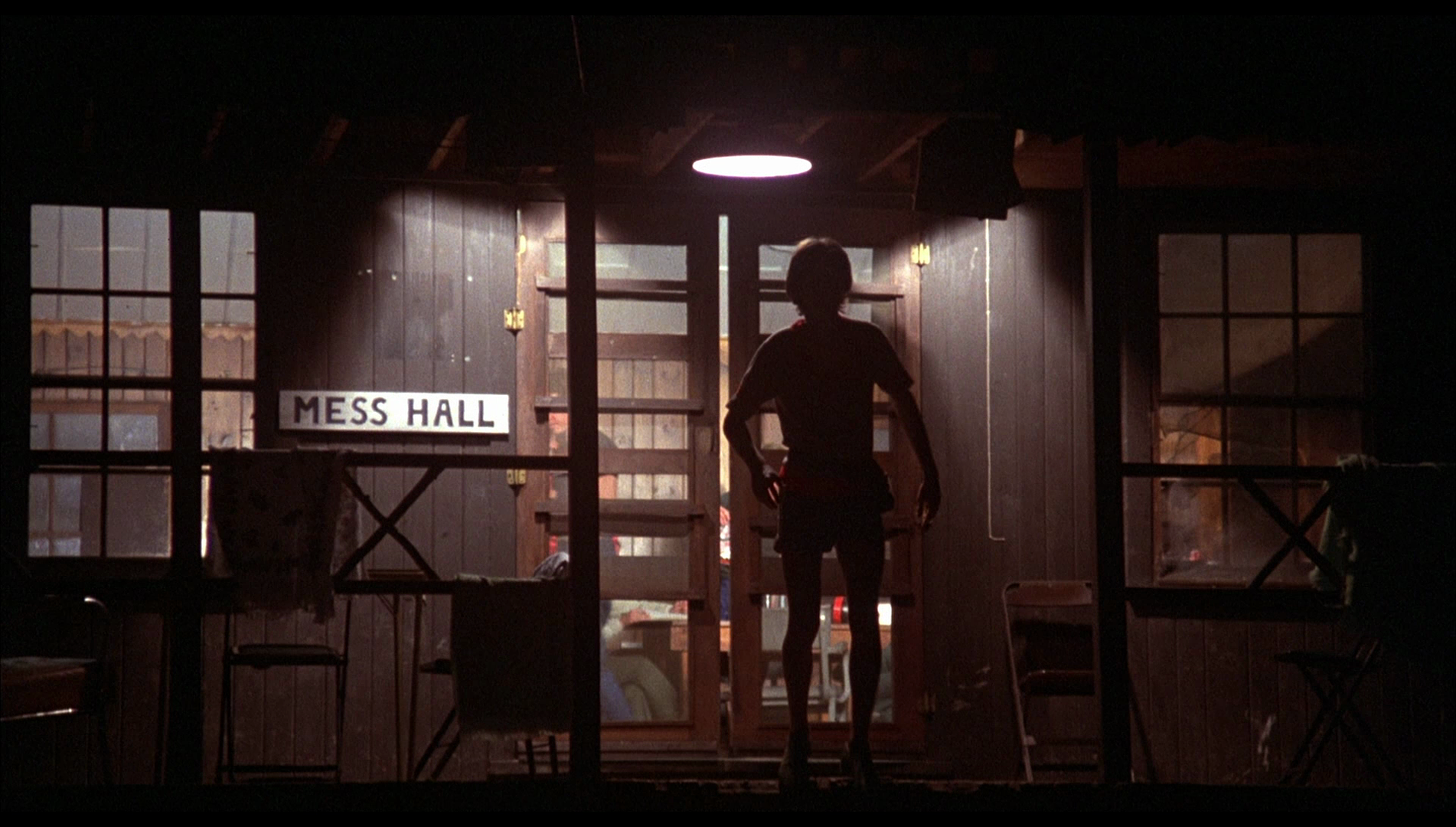
Arrow Video 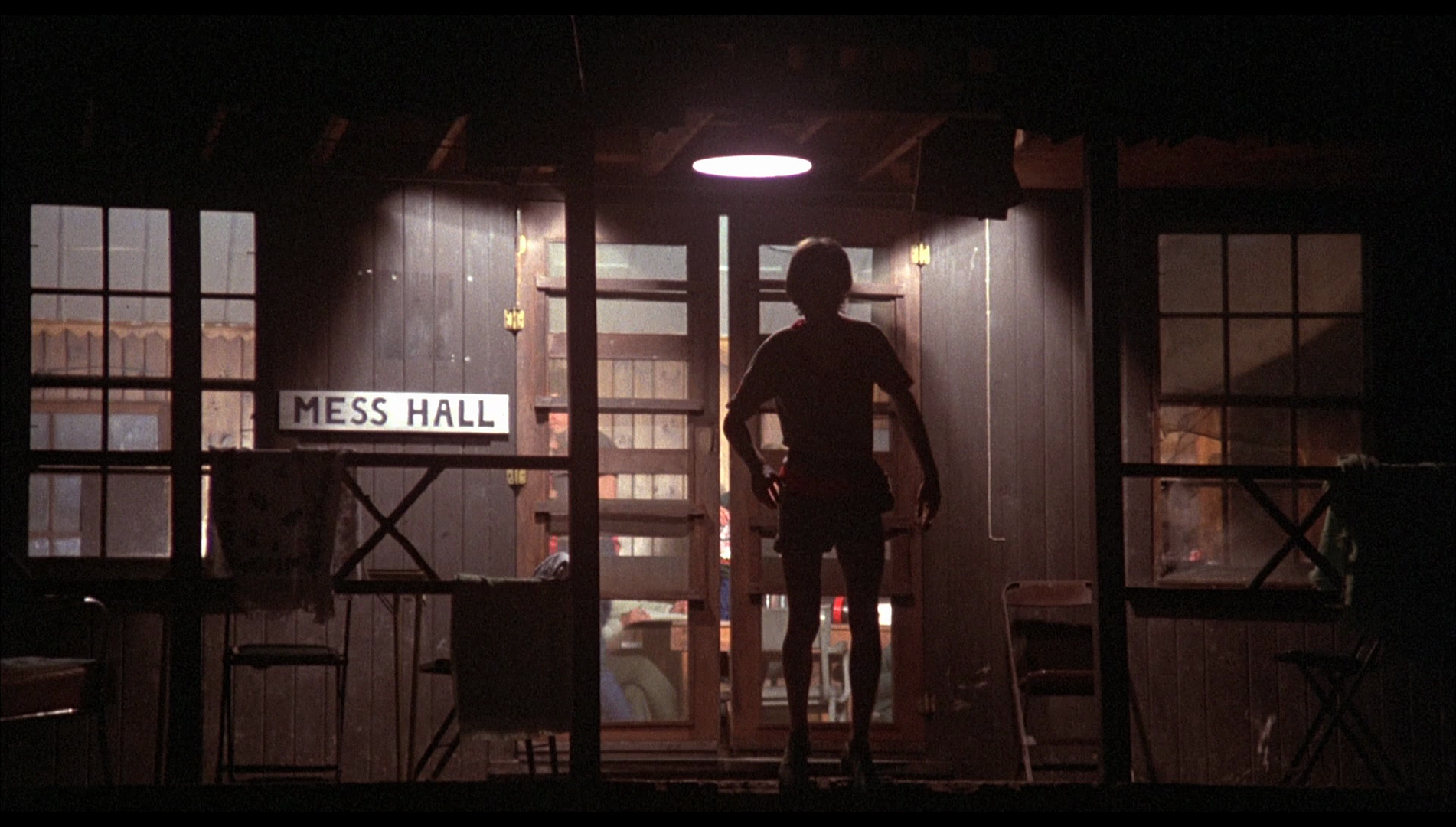
Shout! Factory 
Arrow Video 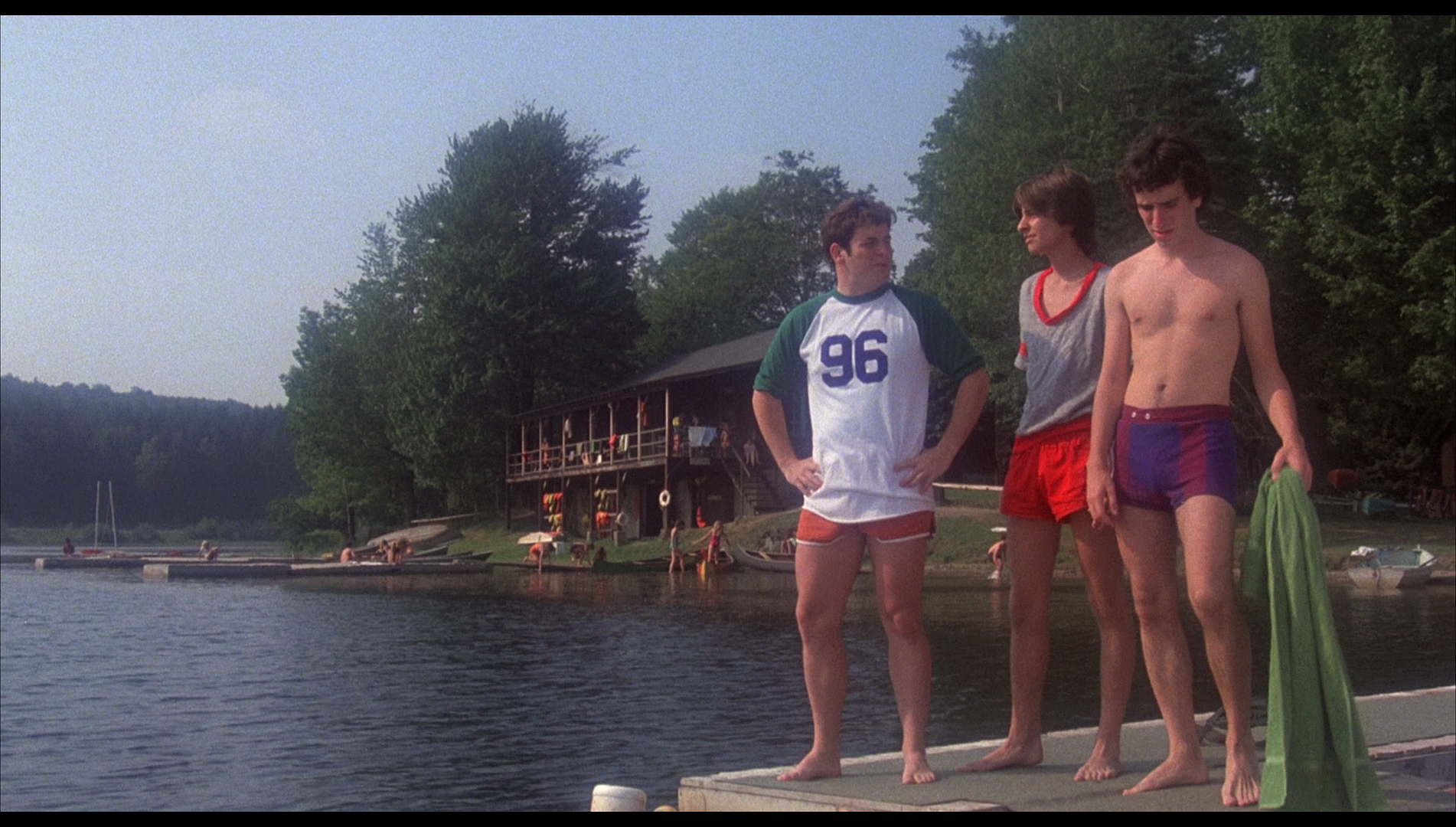
Shout! Factory 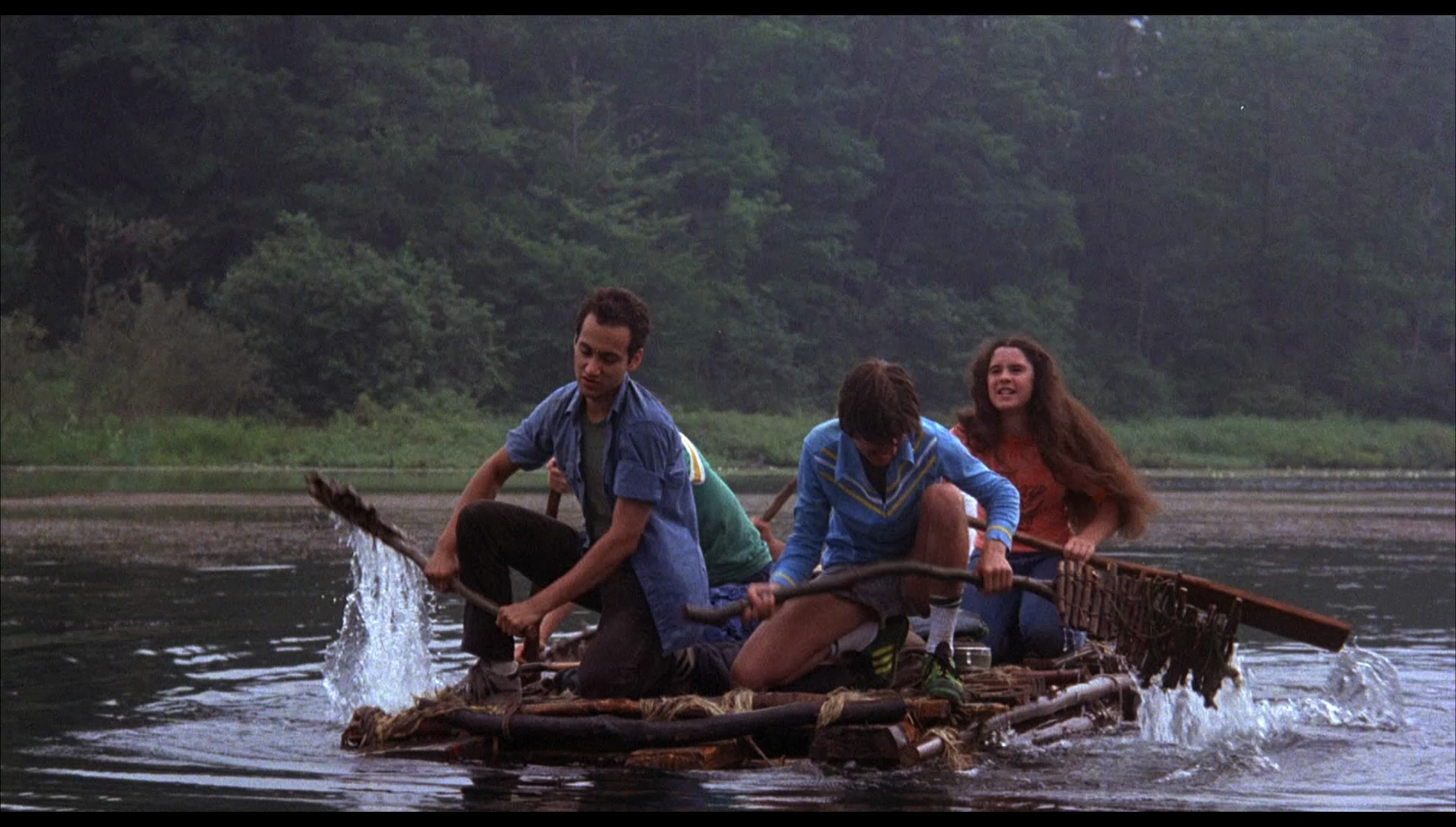
Arrow Video 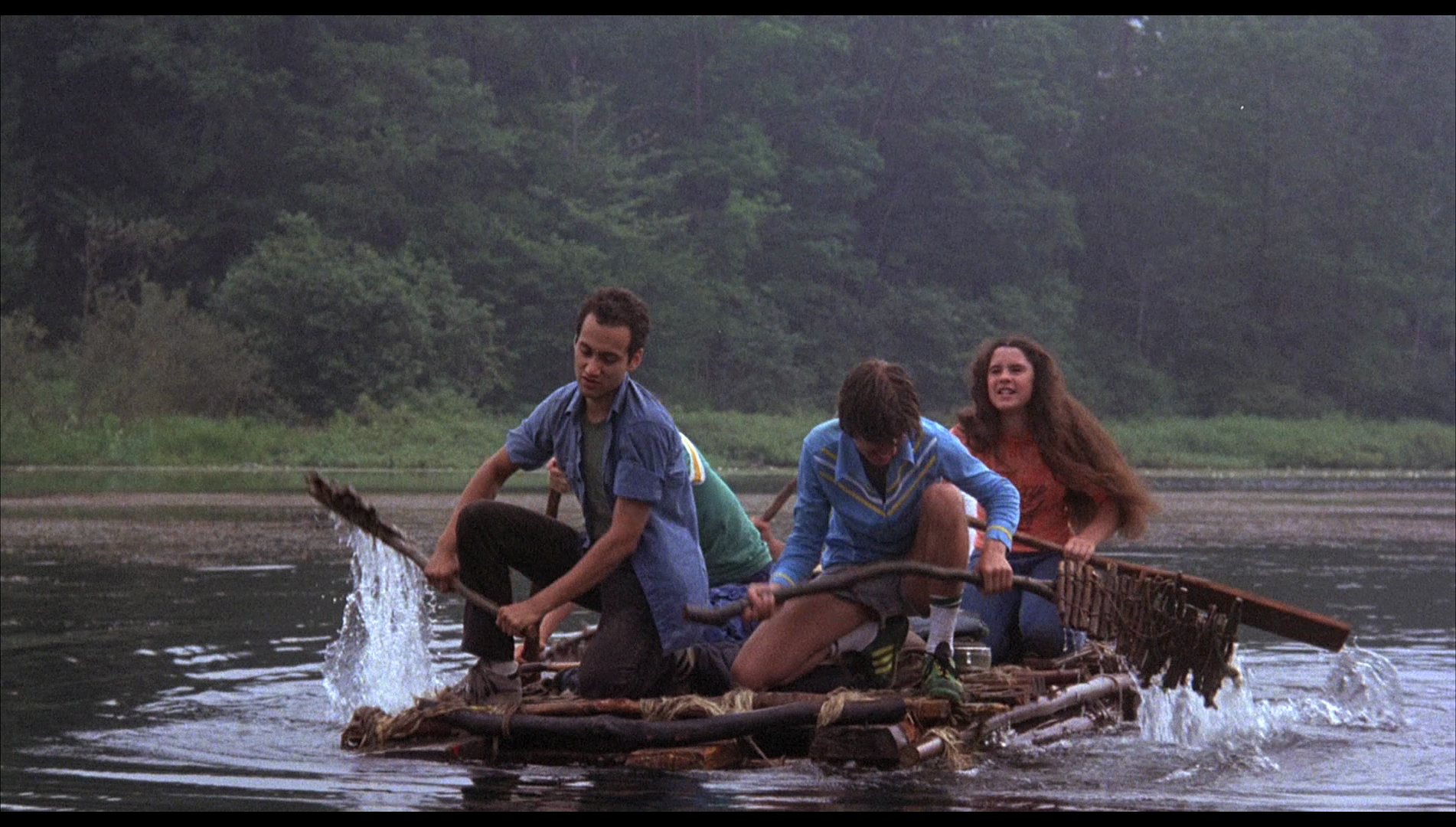
Shout! Factory 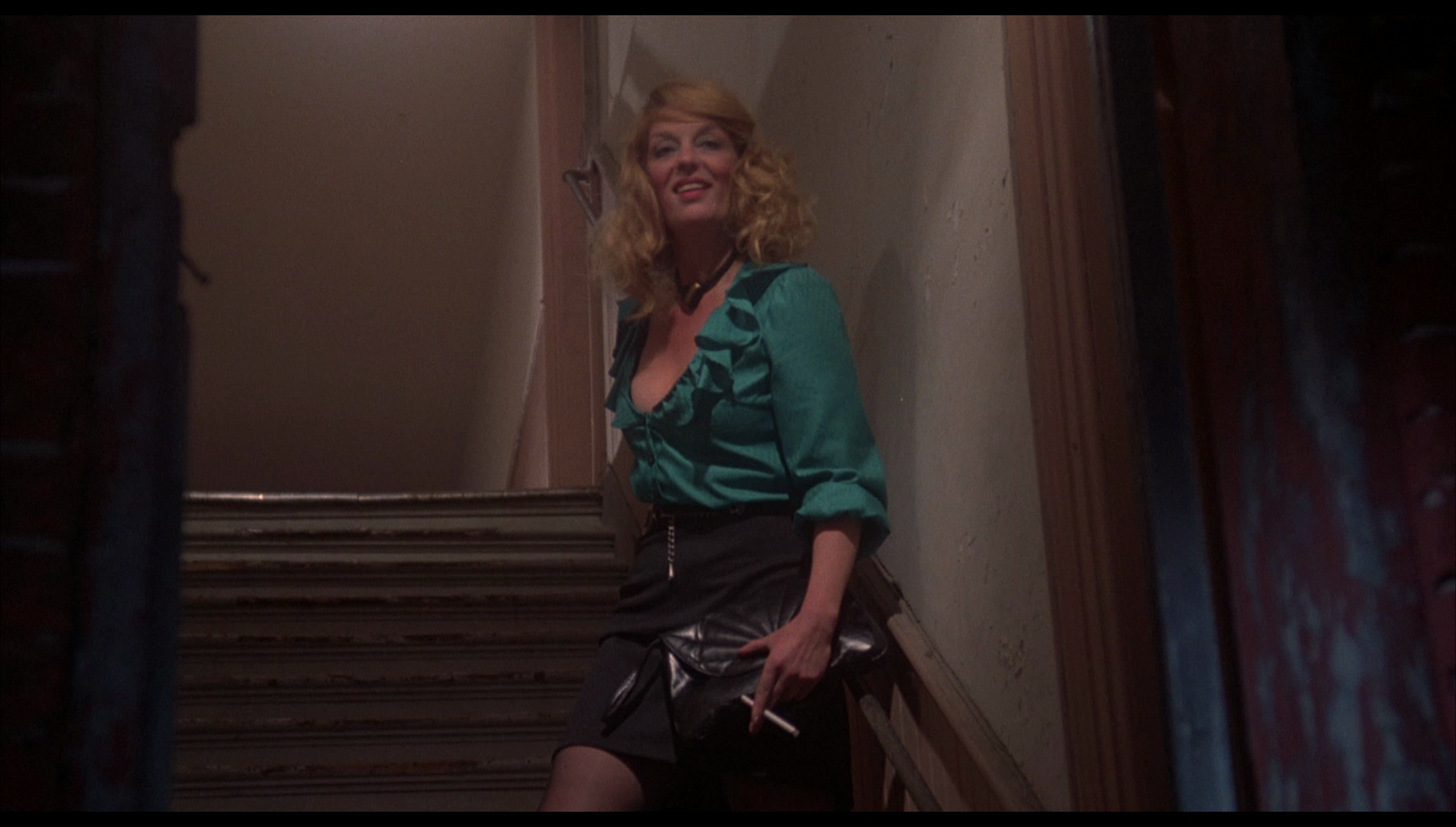
Arrow Video 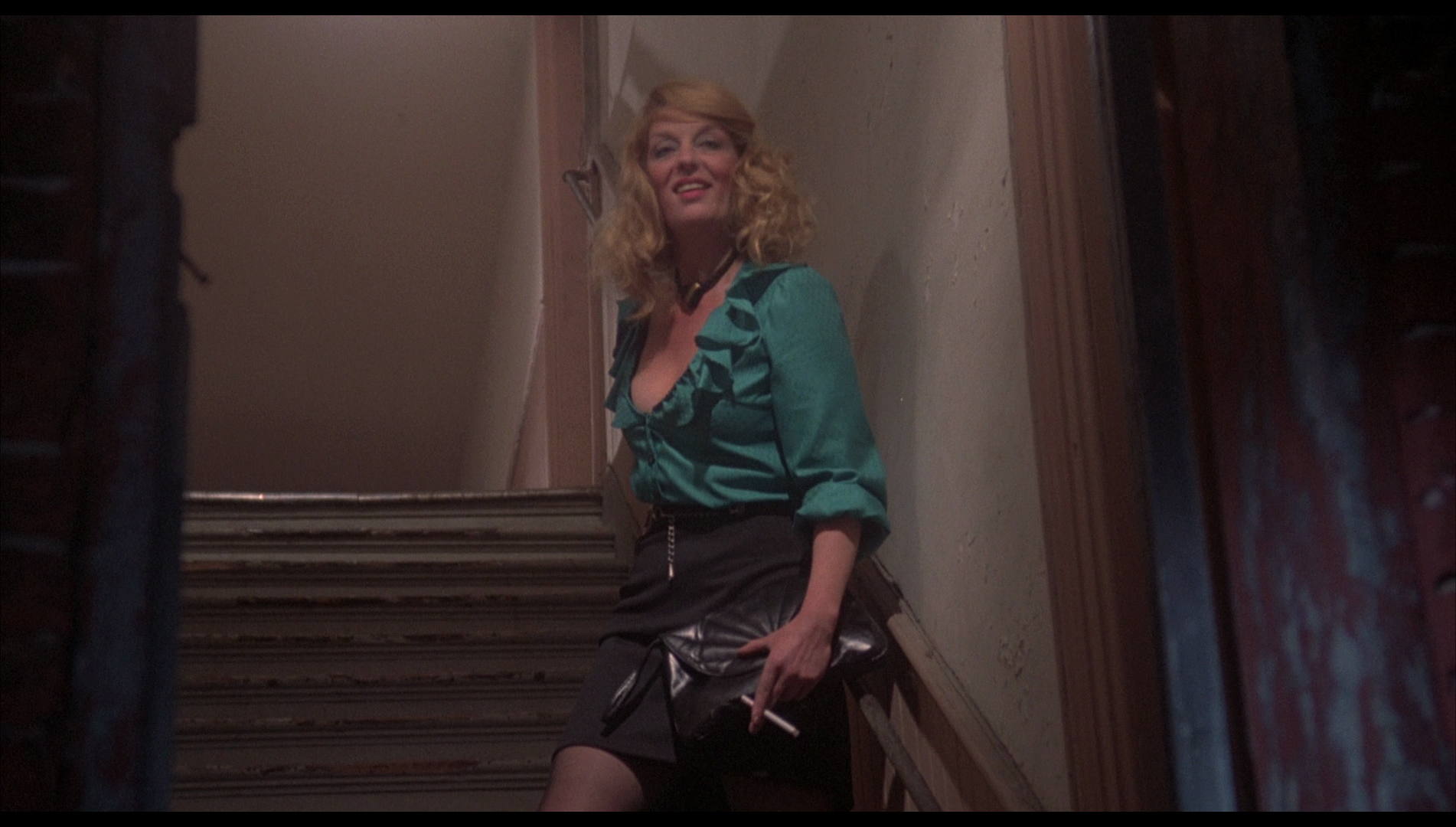
Shout! Factory 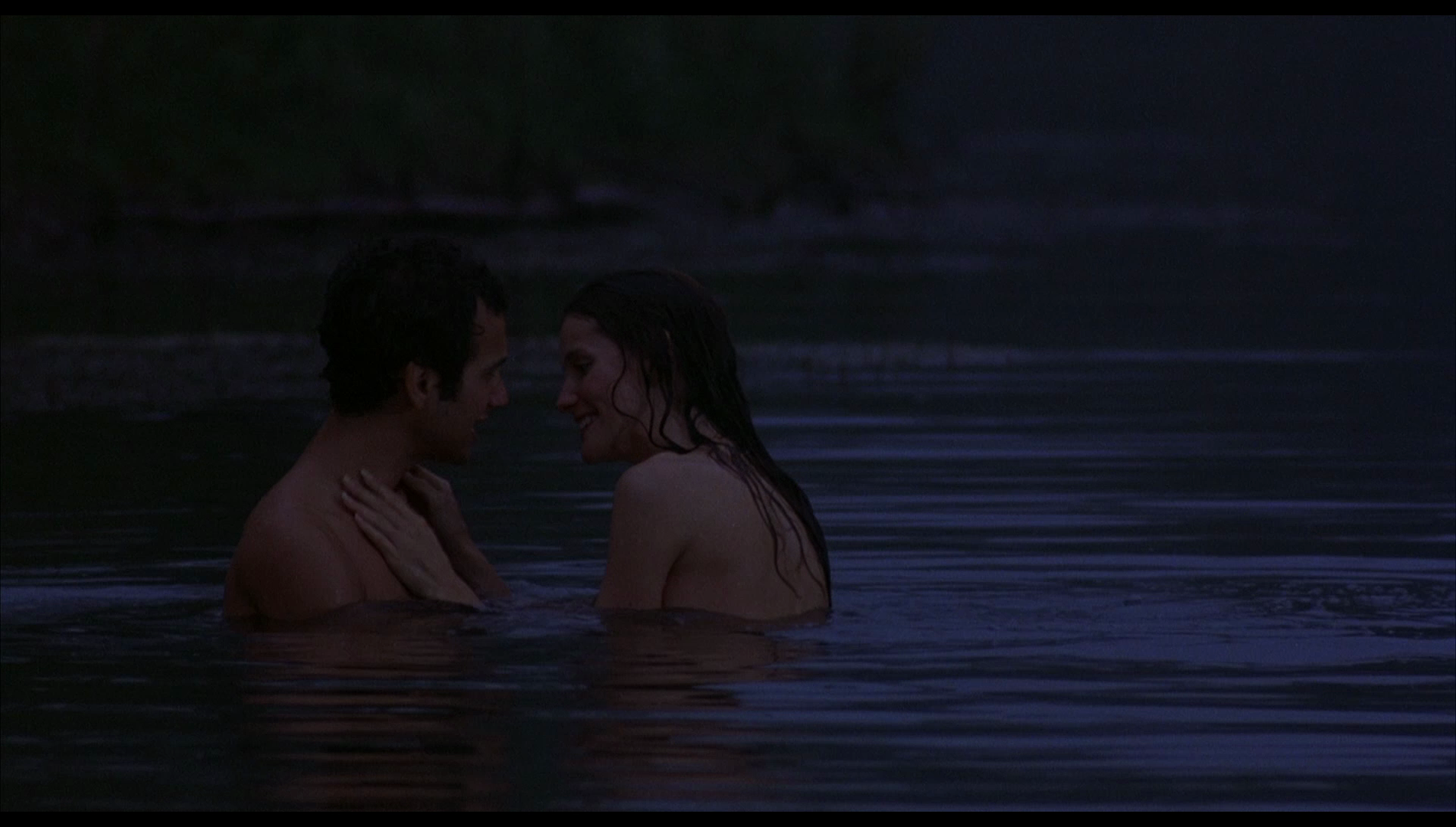
Arrow Video 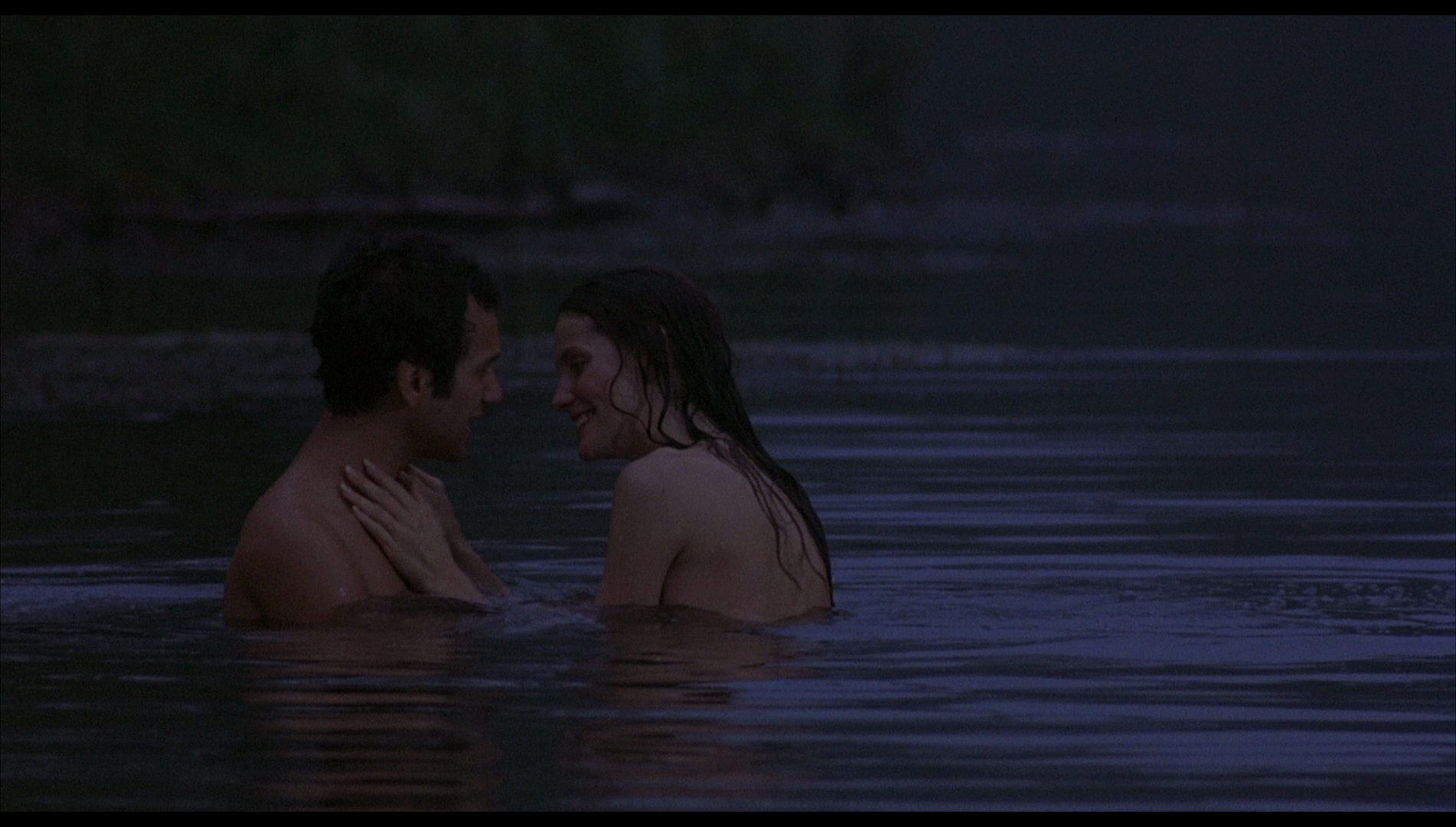
Shout! Factory 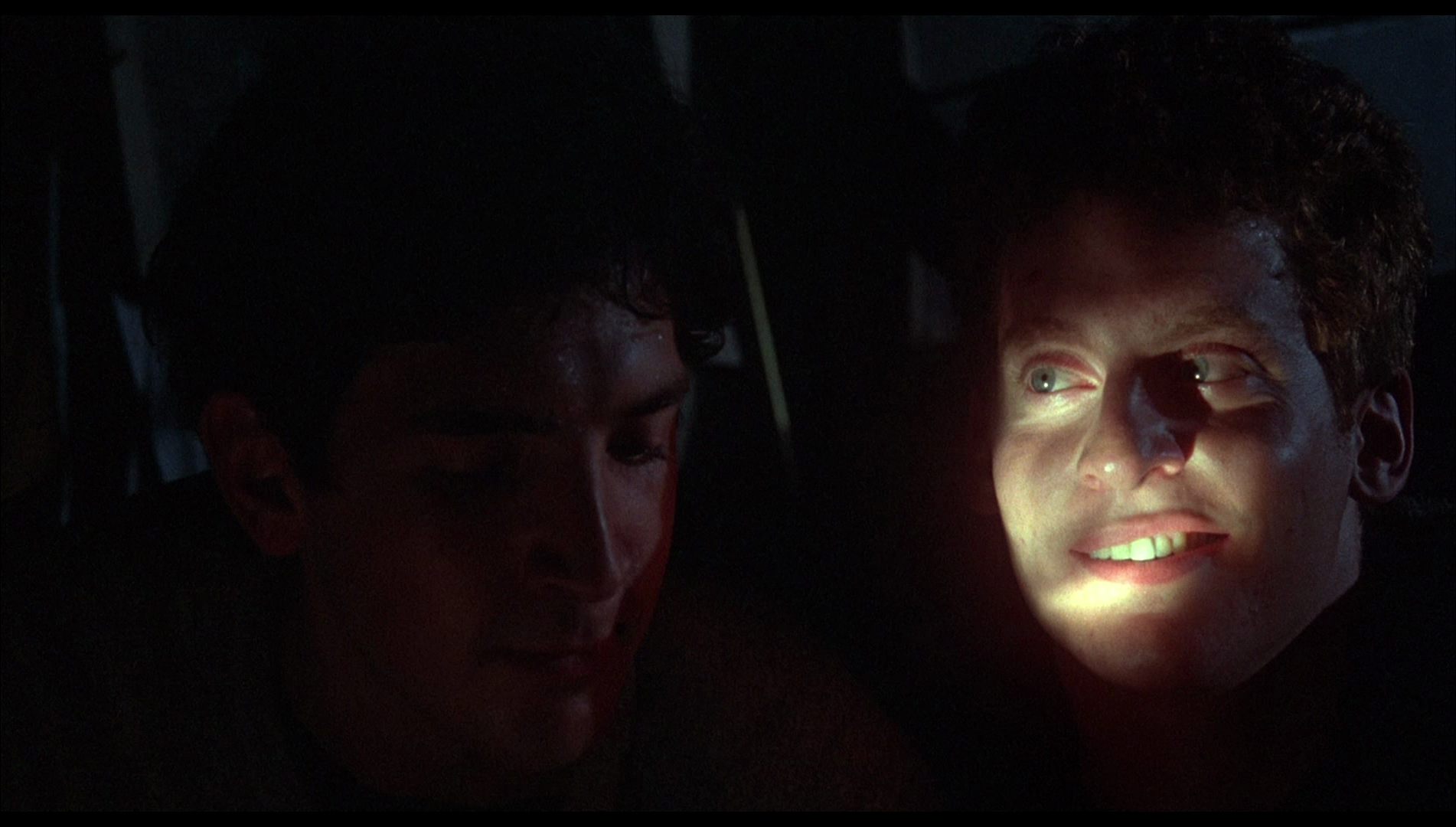
Arrow Video 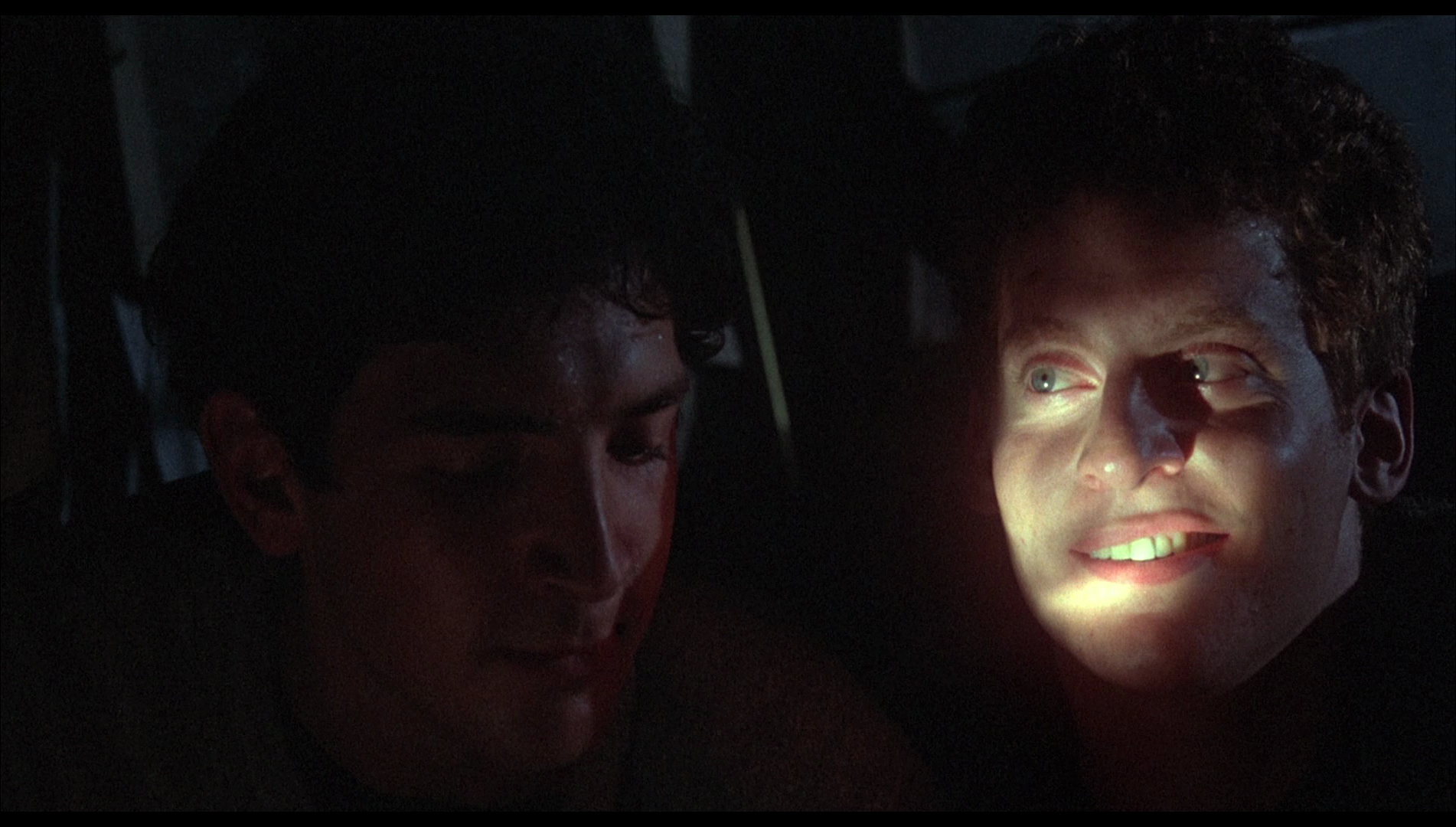
More grabs from the Arrow disc: 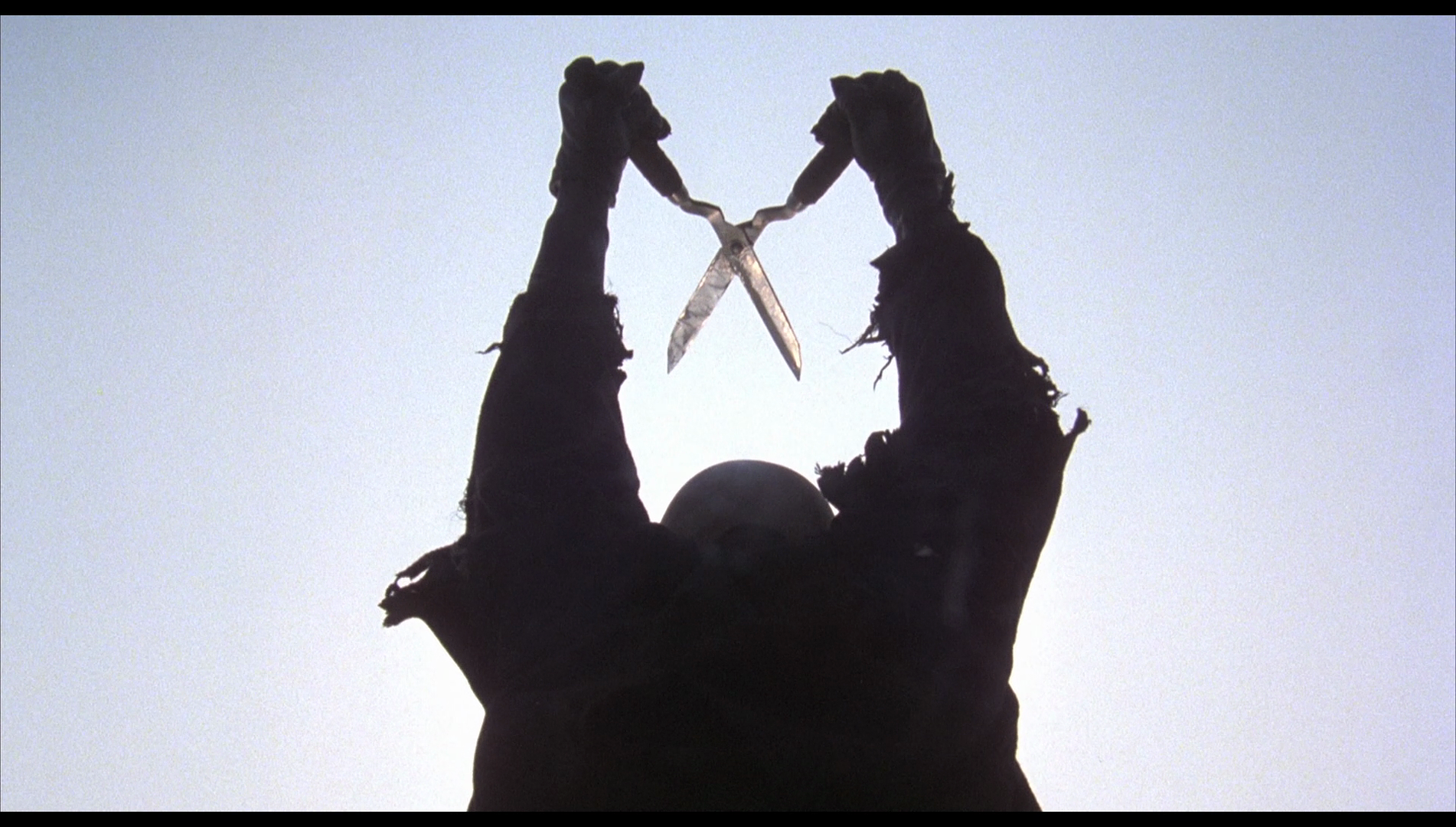
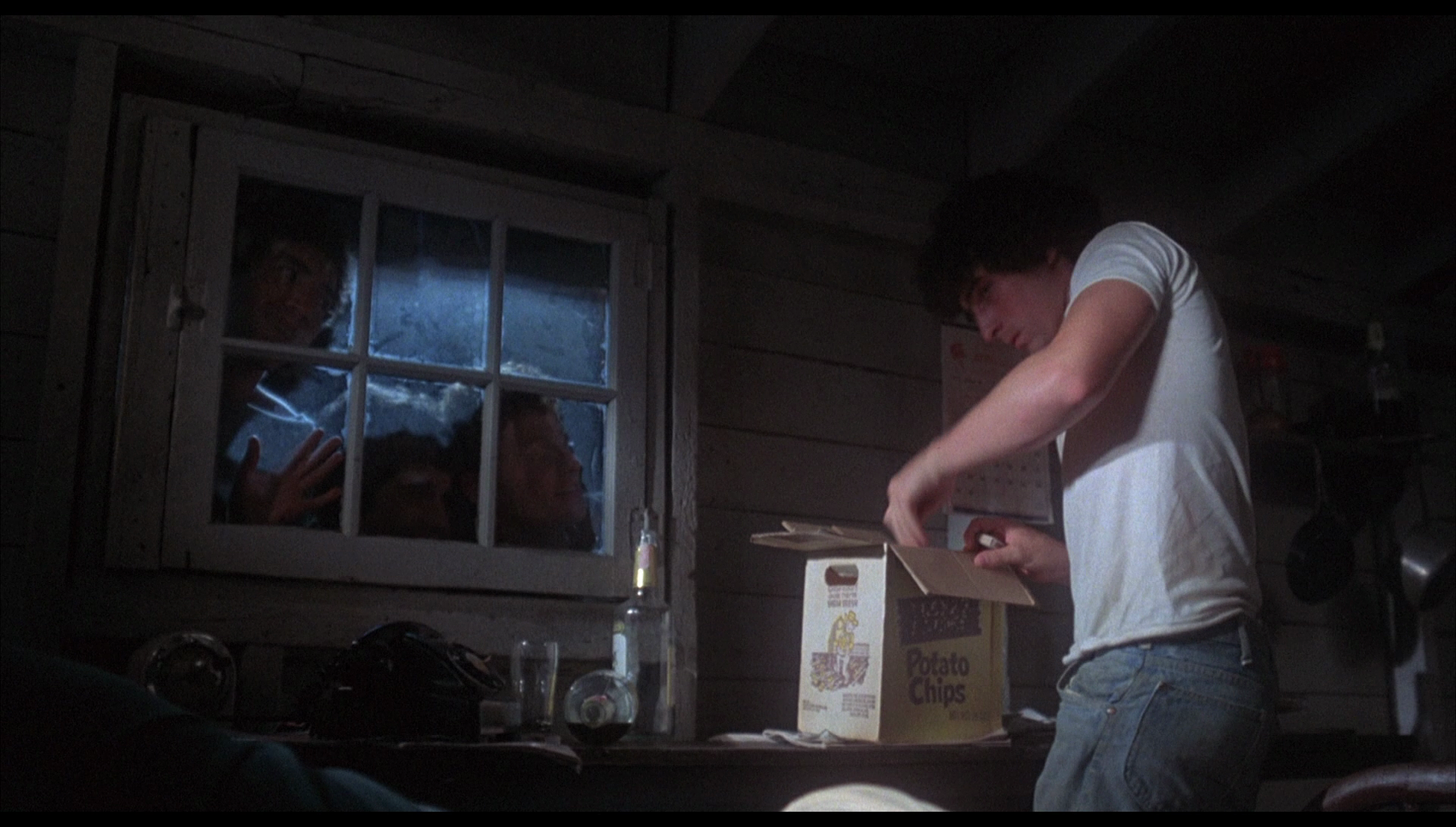
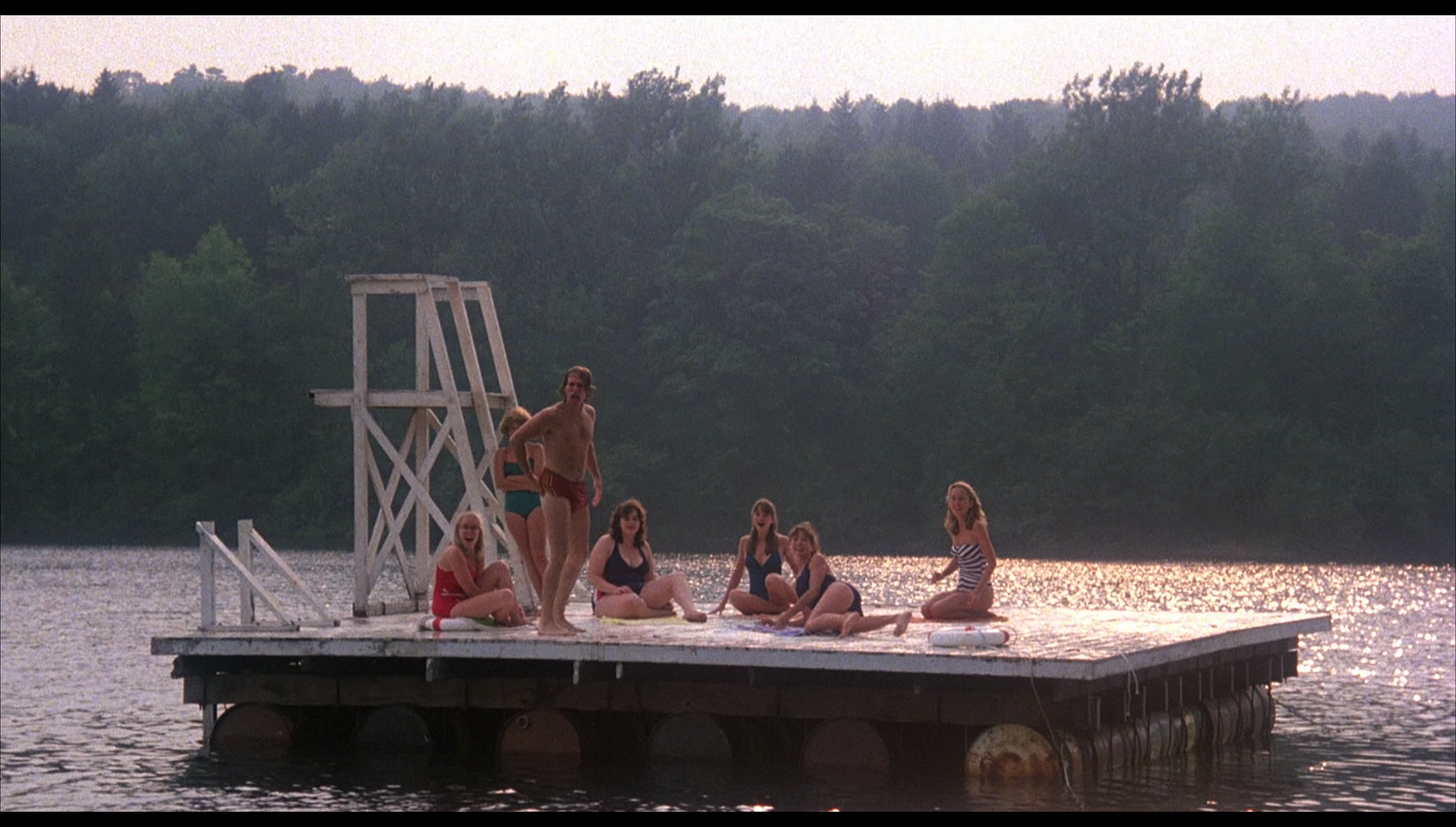
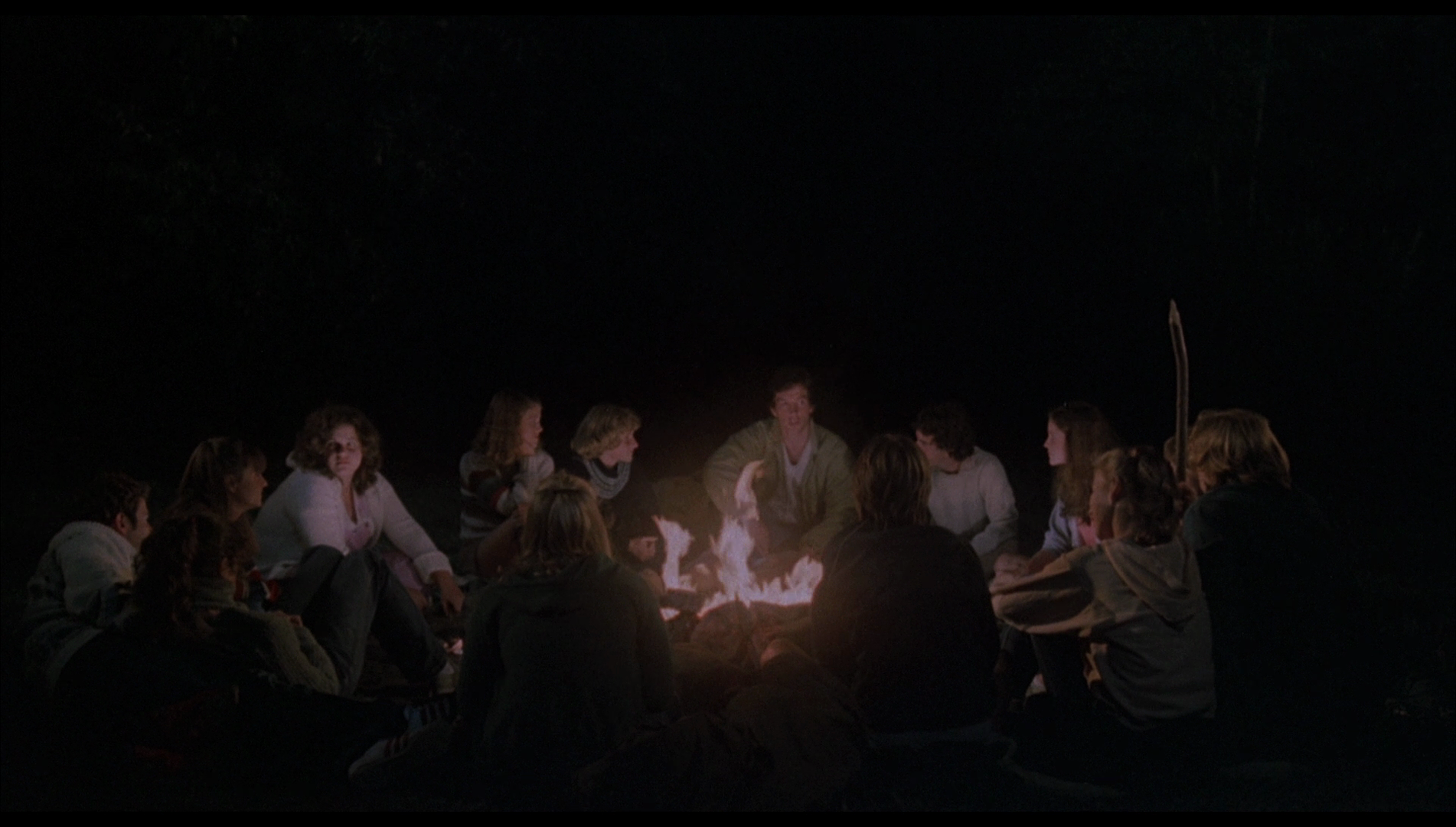
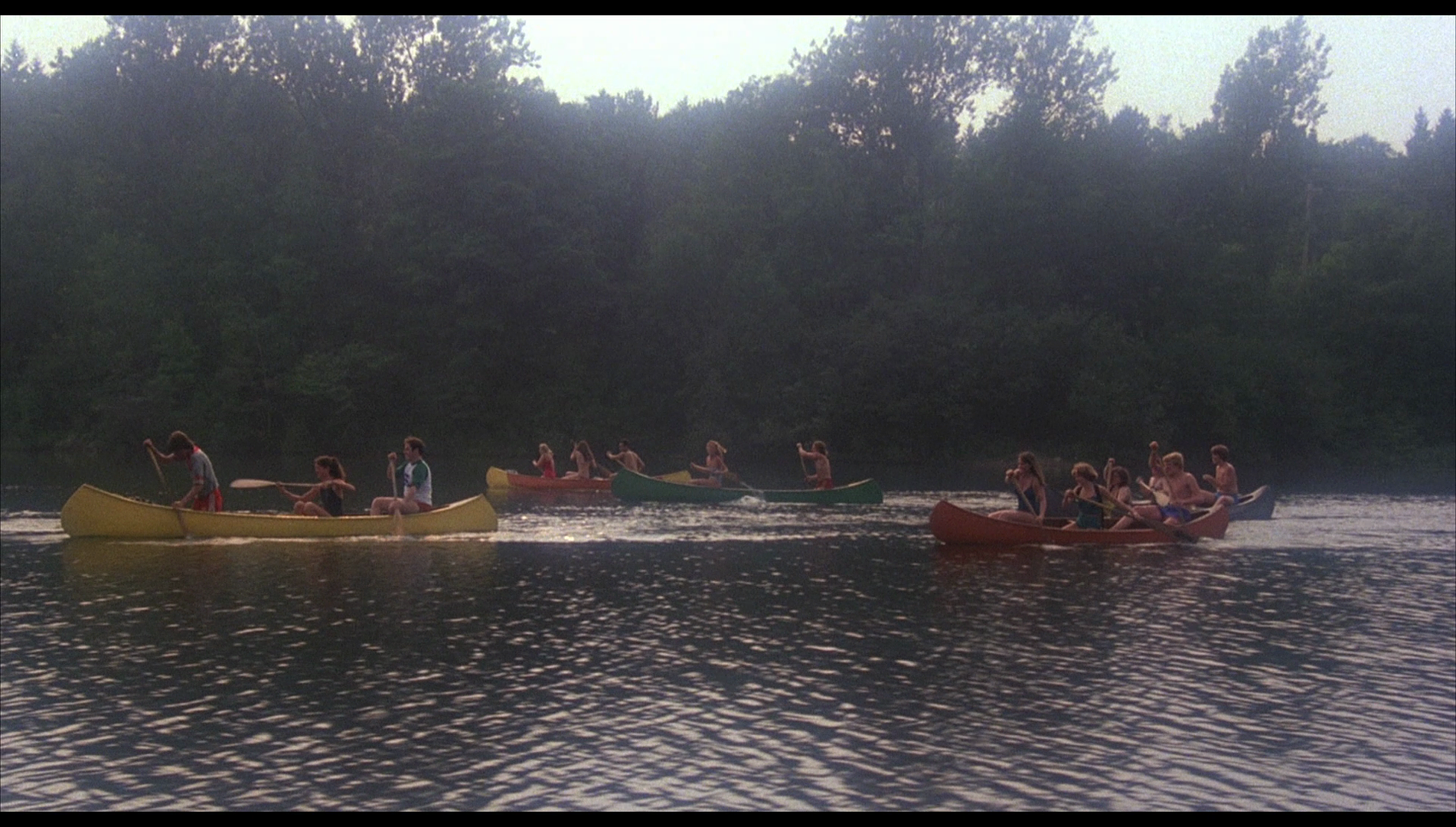
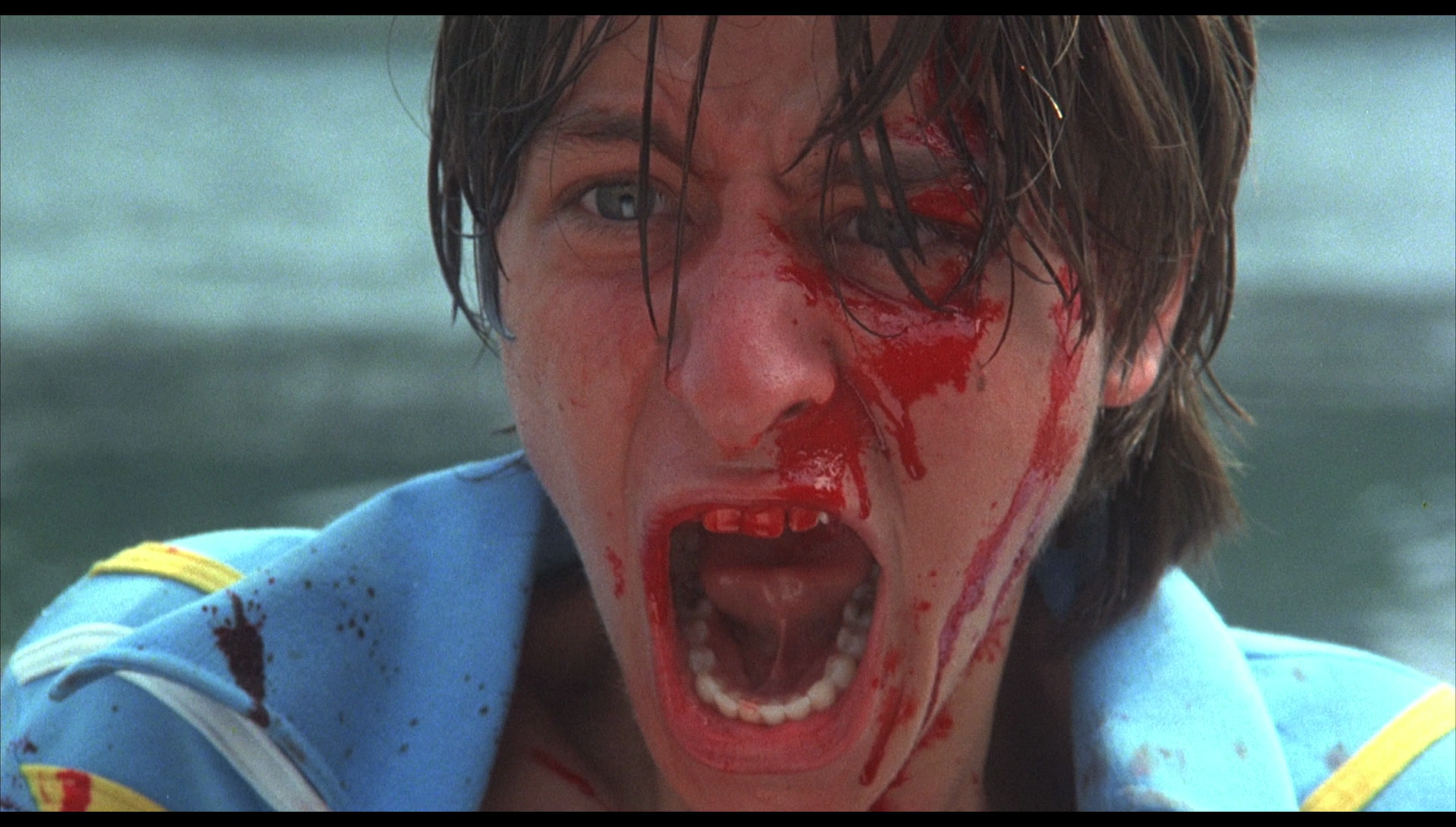
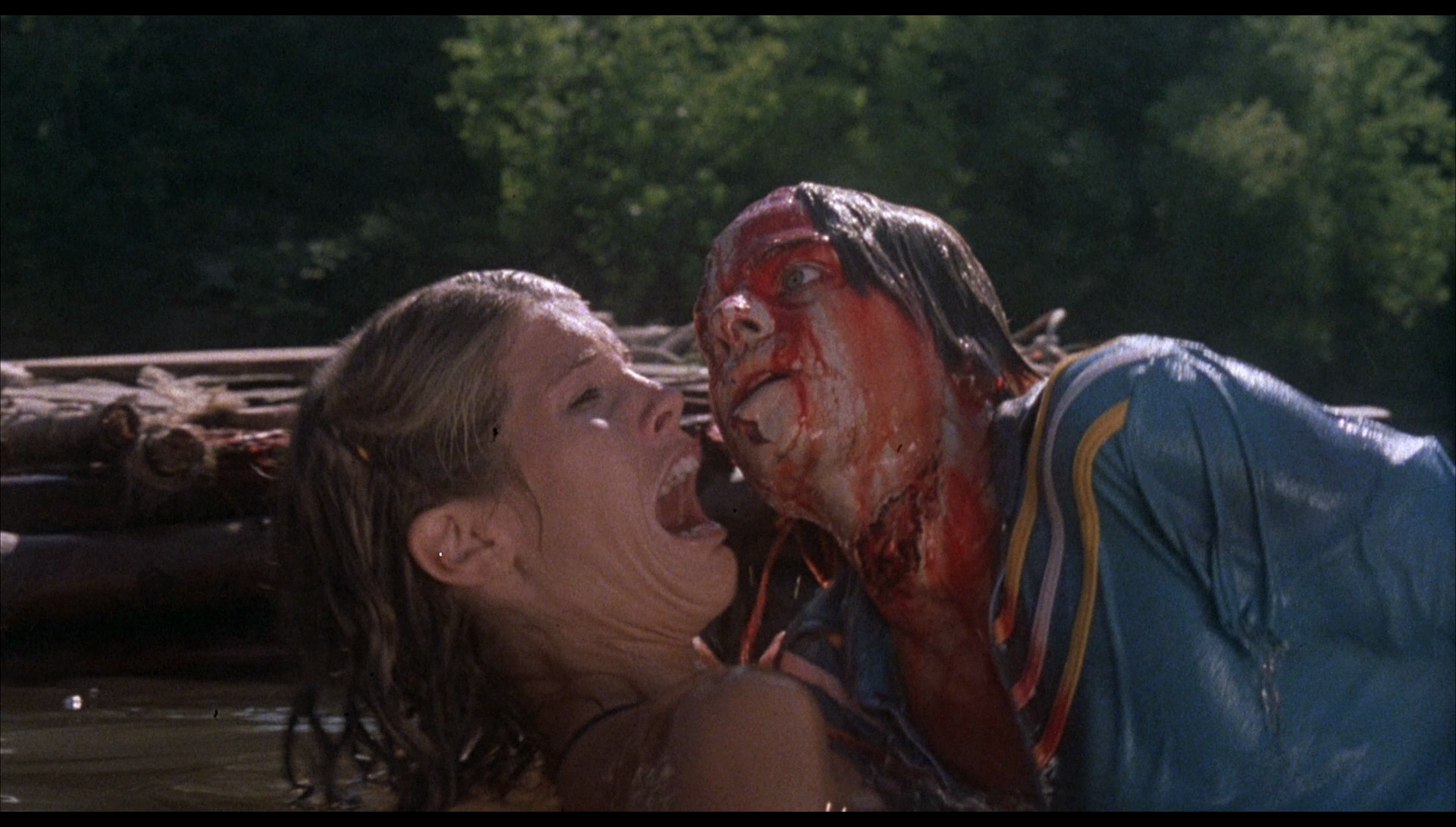
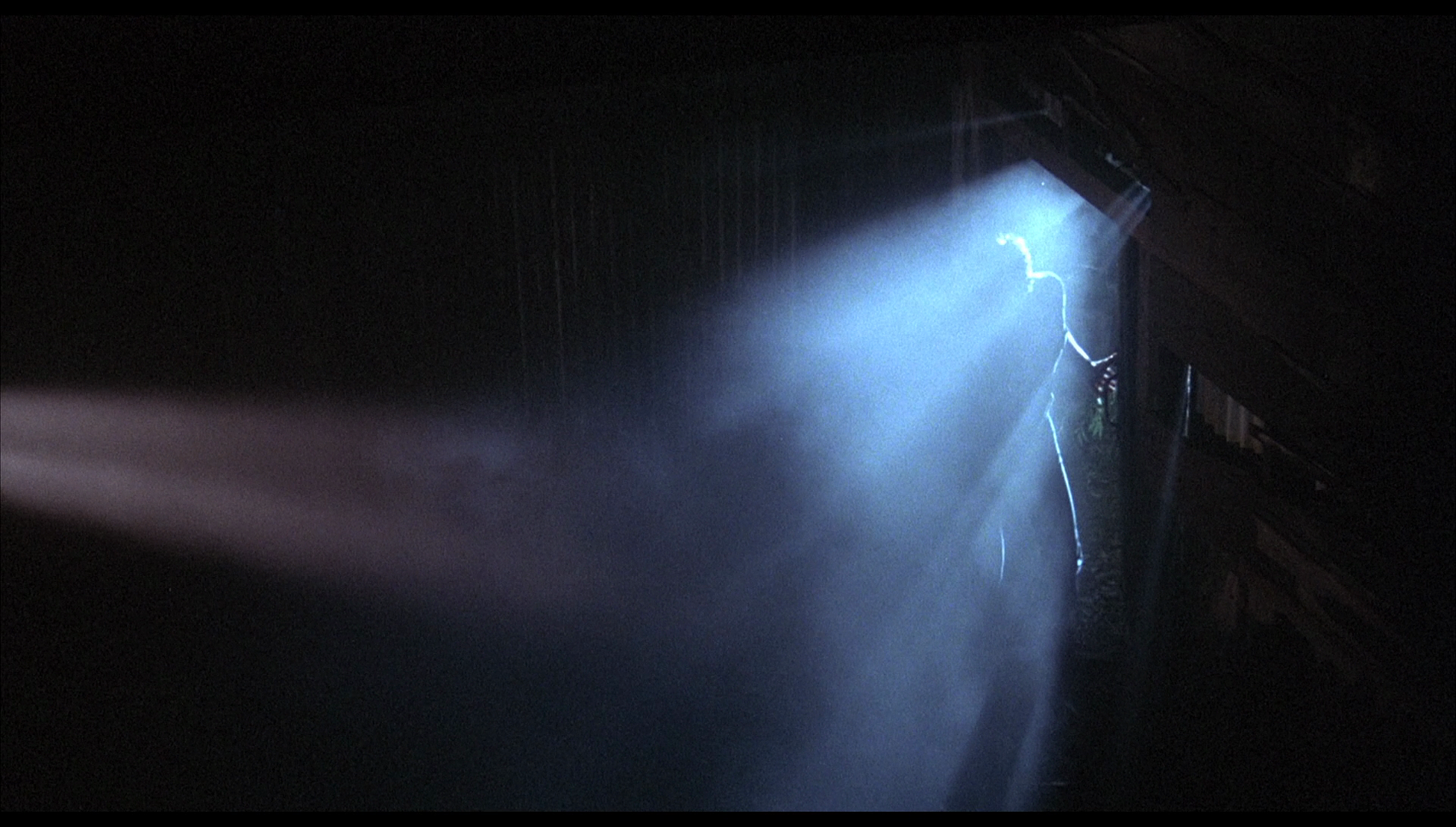
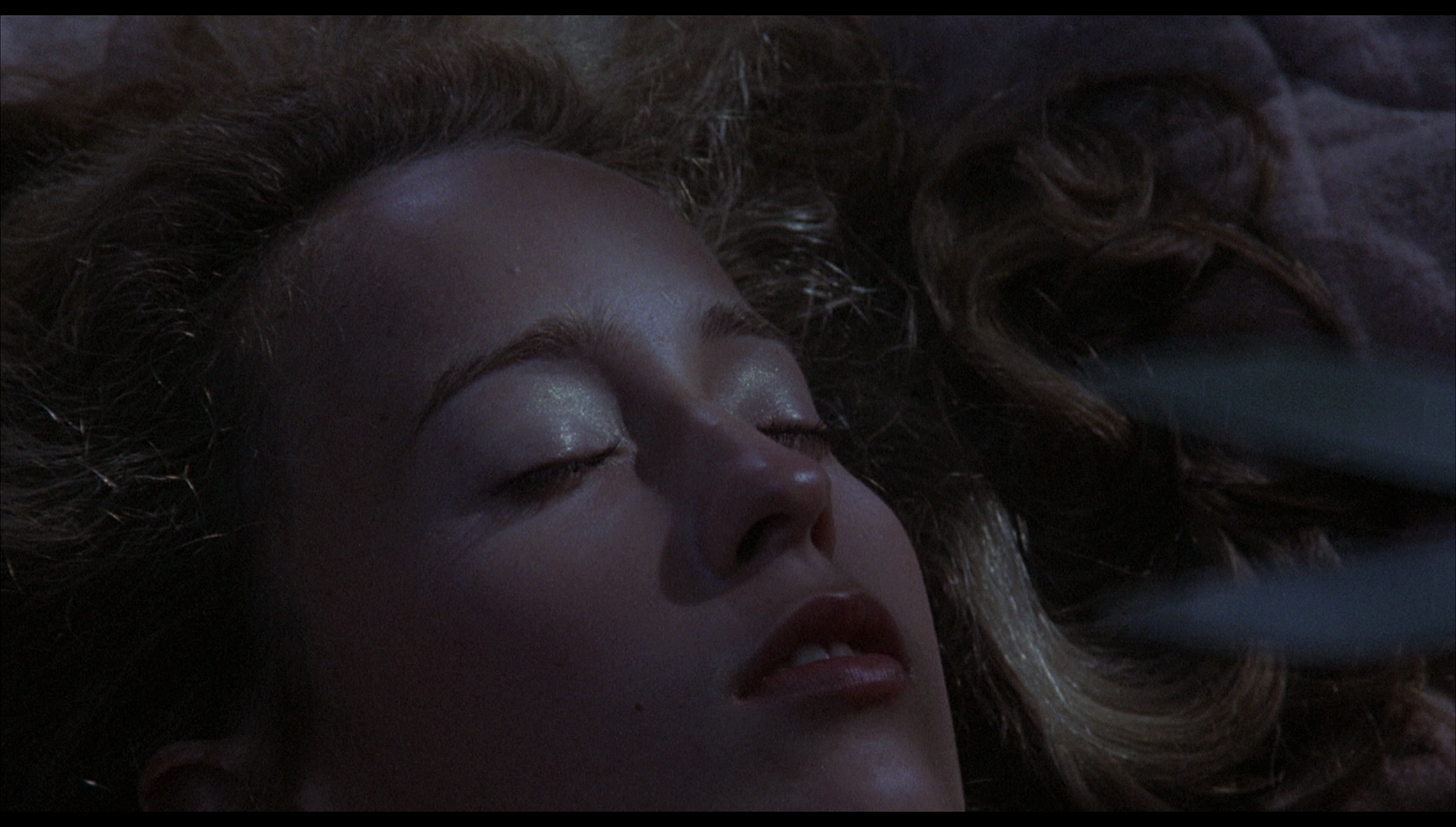
|
|||||

|